Category Archives for "Learn Drums"
Videos and articles on drum practice, techniques, products that help you practice, prioritizing time, etc.
Videos and articles on drum practice, techniques, products that help you practice, prioritizing time, etc.

Here we are with part 2 of the coolest drum gadgets you will probably buy on impulse in the next few minutes! It's one of them moments where you scream, "Take my money!". I have found so many new cool gadgets that I had to make a second article! Check 'em out!
Drumnetics Magnetic Kick Pedal
DOUBLE BASS or SINGLE BASS PLAYERS! All drummers that use a bass drum pedal! You have to check this out! The Drumnetics Pedals are bass drum pedals driven by magnets rather than springs! As a disclaimer, I have not bought one of these myself but I would love to get one! This design is truly unique and innovative. This is a new product and a young business and the few people that actually own one right now have nothing but good things to say about the fluidity and movement. Luckily the construction is very heavy duty—resembling Trick drum products. You can get single or double pedals in short or longboard styles. I will be getting one soon! Check out the features and adjustment options in this video:
Sunhouse Sensory Percussion
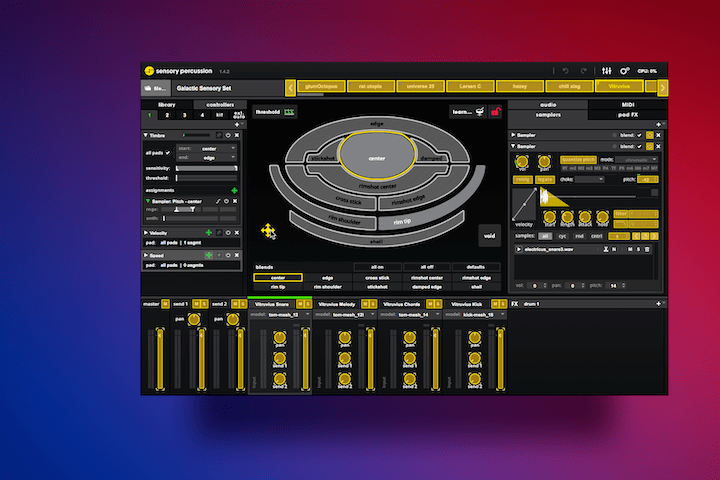
Sunhouse Sensory Percussion Trigger & Software (view item on Amazon) (commissioned links)
Sunhouse Sensory Percussion is so cool! It is the future of electronic drum sound and experimentation. Simply put, these are drum triggers that clamp onto the drum and have a variety of sensors to capture the vibrations of the entire drum. But they are not MIDI drum triggers. They connect via microphone cables (XLR) and can read 10 different zones with high precision dynamics. This is far more sophisticated than basic on/off messages with MIDI.
This is what makes the Sunhouse Sensory Percussion system literally 10 times that of a MIDI trigger setup. They work with regular or mesh drum heads and you can use them with any third party interface and connect them into the Sunhouse Sensory Software on a Mac or PC. You could buy mesh drumheads for any old inexpensive drum set and turn it into a electronic kit or create any hybrid setup you can imagine. This is where you could get artistic and make drums out of unique materials, devoid of sound because the Sunhouse system will turn them into whatever you want. The sound manipulation is far more advanced than anything you can do with MIDI triggers. You have to take some time to really check out this amazing and innovative tool! Watch their demo videos:
Yamaha EAD10

Yamaha EAD10 (view item on Amazon) (commissioned links)
I am so impressed with some of the new products coming out right now! The Yamaha EAD10 is a single mic system for your entire drum kit that clamps your bass drum. With extremely intelligent technology, the EAD10 listens to your entire drum kit and can discern each drum within a 4 foot range of the unit. This unit attaches to a module and gives you a wide variety of mix and effect options. I am amazed at the quality of recording you can get out of a one-mic setup for your entire kit. This is the ultimate option for people on a budget wanting to start making their own drum videos. Watch the demo video put out by Sweetwater where he explains all of the features:
Hi-Hat Quick Release Clutches
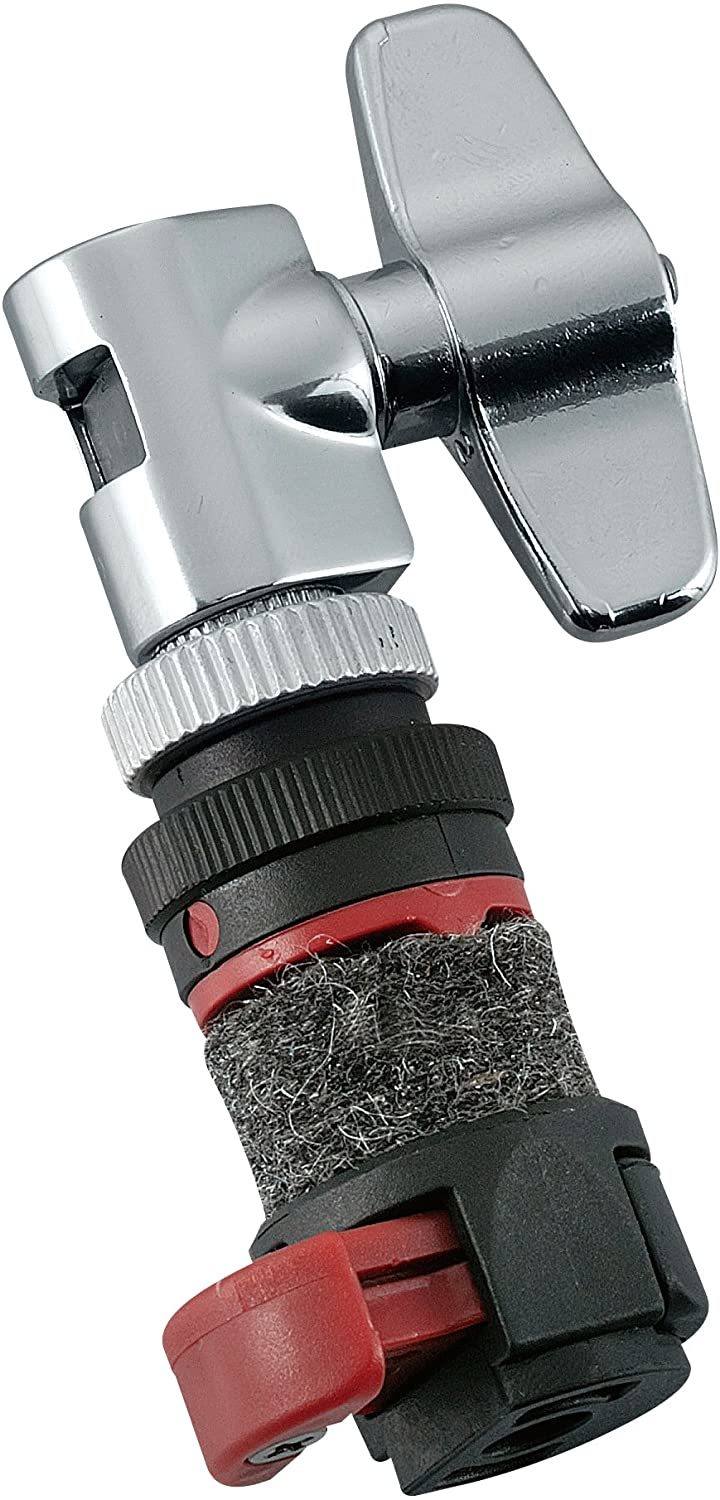
Tama Quickset Hi-Hat Clutch (view item on Amazon) (commissioned links)
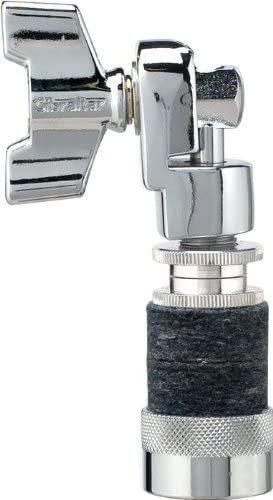
Gibraltar Quick Release Hi-Hat Clutch (view item on Amazon) (commissioned links)
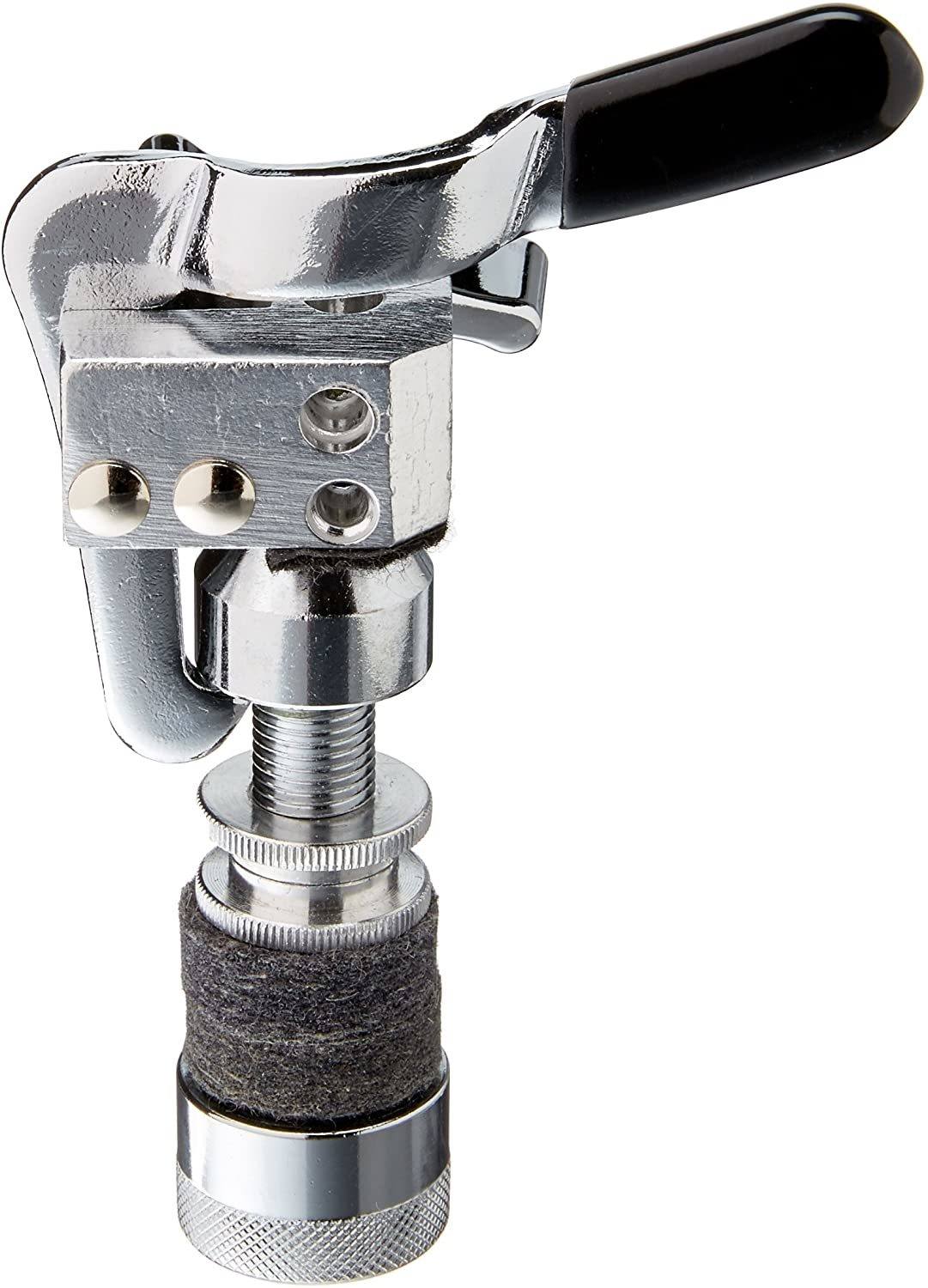
Gibraltar Quick Release Hi-Hat Drop Clutch (view item on Amazon) (commissioned links)
After I fell in love with Trick Drums Cymbal Quick Release, I found myself still spinning threaded nuts on hi-hat clutches. I knew there had to be a product that could solve this issue as well! The Gibraltar Quick Release Hi-Hat Clutch is a super solid, steel constructed product that combines the same idea of the Trick Cymbal Quick Release on a hi-hat clutch. They also make the Gibraltar Quick Release Hi-Hat “DROP” Clutch for double kick players.
With some deeper research, I found that Tama has their own version called the Tama Quickset Hi-Hat Clutch. It is based off of the Tama Quickset Cymbal Mate design. I did not prefer the quickset cymbal mate design with it’s clunky closure and tendency to pop off every so often. However, since the grip clamps to the lip of the customized clutch instead of threads on a cymbal stand, it seems like a solid design.
At this point I would have called the Gibraltar Quick Release Hi-Hat Drop Clutch the winner…but then I found something that I never knew existed. If you read my previous article “The Coolest Drum Gadgets You Didn't Know You Wanted”, I spoke about the seemingly discontinued product, the Tama Cobra Clutch. The Tama Cobra Clutch essentially gives you a drop clutch with the option of tightly closed or sloshy hi-hat cymbals while playing double kick. The hack I created was much cheaper and was achieved by putting a spring on your hi-hat stand. However, the Tama Sizzle Touch Drop Clutch gives you the slosh option WITH the quick release. Honestly I wish Gibraltar had the spring option as well since their quick release construction is better AND they are much more affordable. So with that, I leave the decision up to you!
Snareweight M1 and M80

Snareweight M1 (view item on Amazon) (commissioned links)

Snareweight M80 (view item on Amazon) (commissioned links)
Everyone knows about muffling gels and similar products for dampening their snares or toms. This is an alternative that I think is a little more elegant, sturdy, and effective. The Snareweight M1 and M80 are essentially a snare dampener made of a leathery flap that clips on the rim of the drum. You can turn it off by simply pushing back on it until it magnetically sits off the drum. This turned out to be more sturdy than sticking muffling gels on the drum, especially when they have stopped sticking. The M1 is the small version of the M80. With the M80, you can essentially push back the side flaps to make it the same size as the M1 really giving you two products in one. I highly suggest that you experiment with your drum’s tuning to get the sounds you want without muffling but this is definitely a quick adjustment that can be useful in many situations. They come in brown, black, and white colors.
Firefly Ratcheting Drum Key
Ratcheting style drum keys are super useful when changing heads. The Firefly Ratcheting Drum Key takes it a step further because it is silent when you reverse your movement rather than clicking. This can be ideal in gig and studio situations. This is definitely the best ratcheting drum key out there!
Tru Tuner Rapid Drum Head Tuner
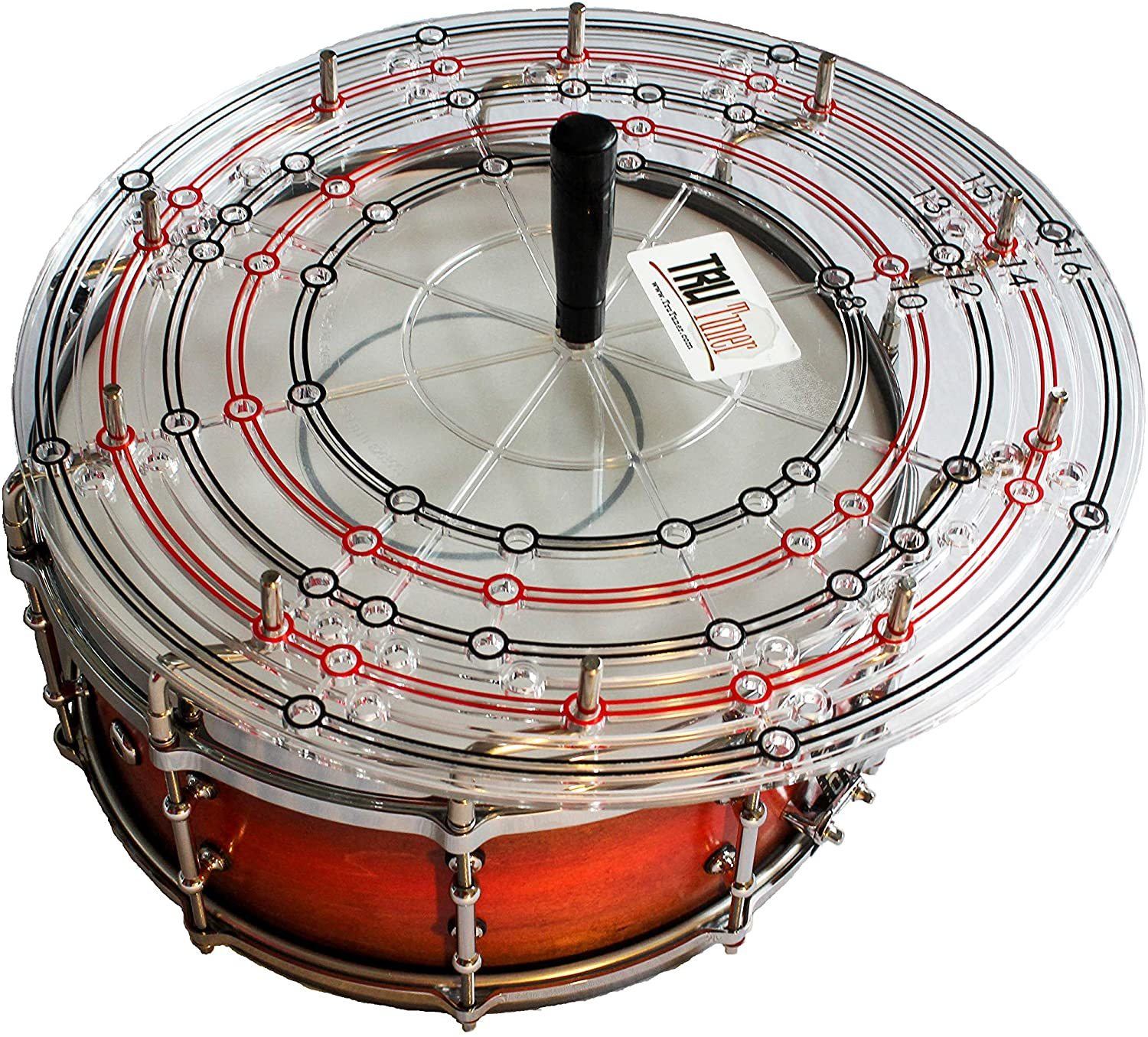
Tru Tuner Rapid Drum Head Tuner (view item on Amazon) (commissioned links)
The Tru Tuner Rapid Drum Head Tuner is a fantastic way to get evenly tuned drums on every lug. You place the included drum keys on all of your lugs and put the “tuning plate” on top of all the drum keys and turn all the lugs at the same time. One setback is that you can’t test the drum sound while the plate is on the keys. But if you have a ballpark of 1 or 2 full turns to get it close, you can be rest assured that every lug is evenly tensioned. You can literally remove and install a new drum head in under 1 minute.
Dialtune Drums
When I first found Dialtune Drums, I immediately saw them as the future of how we tune drums. Tuning drums for so many players at the beginning and intermediate levels can be so overwhelming. It is a time consuming skill to learn which takes away from what you actually want to be doing: practicing and playing! Not to mention all the drummers that are so uninspired by their drum sound because they can’t get their drums to sound good. It is literally the biggest problem for drummers right now!
Dialtune Drums use a pulley system to allow you to evenly tune one head of the drum just by turning one knob located on the side of the drum. There is one knob for the top head and one for the bottom head. The hardware attached to the drums do make them quite a bit heavier than a regular drum. I think the ease of tuning far outweighs the heavier weight (no pun intended).
This is a brand new company that just started offering products to the public at large. As of right now, they only offer 6.5”x14” maple snare drums. As they gain momentum, they will be adding different snare size options, tom options, and eventually full kits. I would keep our eyes peeled for more companies to start building drums like this.
Vic Firth Hingestix

Vic Firth American Custom SD1 Hingestix (view item on Amazon) (commissioned links)
The Vic Firth Hingestix are ideal for teachers and beginners alike. They are basically an removable rod that screws into 1 of 2 pre-made holes on the sticks to help remind you where your fingers and/or fulcrum should be. If you have trouble sliding around your stick, they do help a little bit with grip as well.
Tru Tuner FX Series

Tru Tuner FX Shaker Stick (view item on Amazon) (commissioned links)

Tru Tuner FX Drumhead/Cymbal Mount Tambourine (view item on Amazon) (commissioned links)

Tru Tuner Bass Drum Mounted Shaker (view item on Amazon) (commissioned links)
In addition to their Rapid Drumhead Tuner, Tru Tuner also came out with an FX series of gadgets that are really cool. Essentially, they are small and inexpensive attachments to your drumhead, kick pedal, cymbal, or sticks to add shaker or tambourine sounds while you play. I think all of these have great uses and they are super easy to switch out between songs…or in the middle of songs! There’s a quick release mount attachment for you bass drum beater, a sticky drum muffling gel and a mount to place onto cymbals or drumheads, and a butt-end stick mount. With these mounts you can add a shaker or a mini-tambourine cymbal. My favorite was the sound of the tambourine and muffle gel on the snare drum.
Thank you for reading! I hope the products were helpful in simplifying your drumming life. If you haven't checked out some of my other helpful articles, do so below!
Part 1 of this series:
The Coolest Drum Gadgets You Didn't Know You Wanted
Other articles that may interest you:
Everything You Need to Become an Online Session Drummer - Part 1 – Getting Gear
Definitive Drum Practice Guide from Beginner to Advanced - Part 1 - Scheduling and Gear
Definitive Drum Practice Guide from Beginner to Advanced - Part 2 - Practice Session
**Full Disclosure: I earn a commission if you click any of these links and make a purchase, at no additional cost to you.**

One of the biggest problems we face as drummers is finding a space to practice without bothering anyone. We’re loud and we don’t have a volume knob...well sort of.
I’m going to give you every option you have to make practice possible at almost any time of day. Some options are expensive, some are not. Some are a quick fix, some are not. You need to decide what will work for you.
Location, Location, Location
First of all, there are some natural options you should consider when you are selecting which room to practice in. Select a room that is in the basement or partially underground and located as far away from the “irritated party”. The sound will carry a lot more from a land level or upstairs room. If it is the neighbors you are concerned with, choose the side of your house that is further from your neighbors house OR the side where your neighbors garage might be located. Hopefully they don’t hang out in their garage as much and wouldn’t be as bothered as if you were practicing next to their living room. Also, a room with less windows will conceal the sound better too.
Disclaimer
I would like to explain that some of these options might provide an opportunity to practice at the expense of feel, convenience, or normalcy. You have to recognize that and not let it change you playing for the worse.
I mentioned that we, as drummers, don’t have a volume knob. However, we can learn to play with quiet dynamics. It’s actually very important but also difficult...especially when your just starting out. Learning to play everything loud AND quiet will help your playing immensely. Remember that. Some of these options give a volume knob or remove the volume of your drums prohibiting you from practicing dynamics.
Some of these options will change the feel and/or rebound of the drums. If your playing on rubber or mesh pads, the bounce may feel considerably different than real drums. This can help or hinder you.
Being aware of these differences will help you adjust when your back in a full volume situation.
Simple Solutions
I’m going to start with the easiest and/or least expensive options and go on from there.
Acoustic Drum and Cymbal Pads
If you don’t have the room for a separate pad kit, you might just want to put pads on your acoustic kit to mute them. These may seem convenient but they can drastically change the rebound of the drum. They make them for any size drum and even cymbals. These are more ideal for working coordination or new beats rather that intricate nuances or feels.
There are two options for drum pad sets. You can get the quality drum pads from Vic Firth or this really inexpensive off-brand.
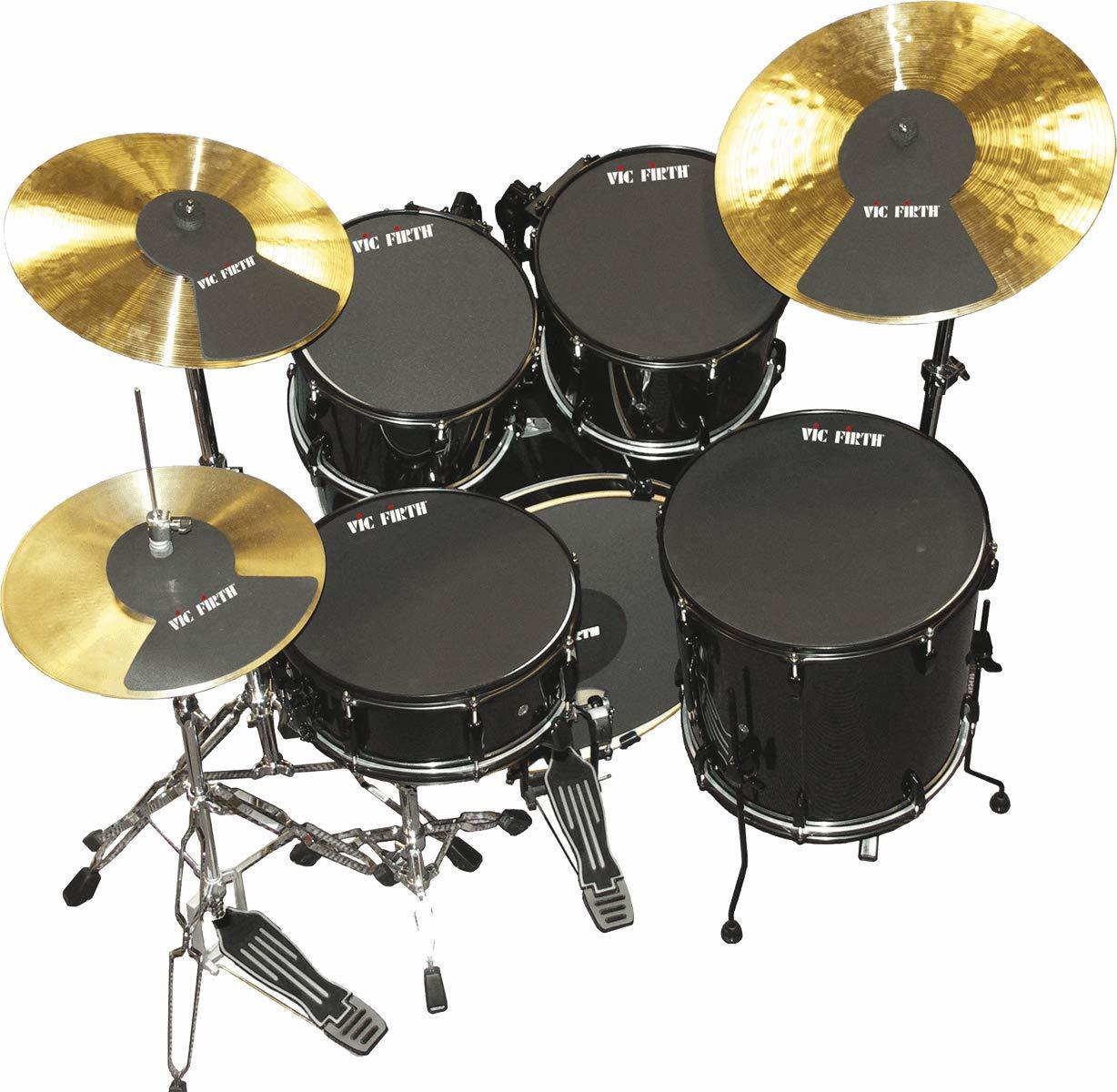
Vic Firth Drum Mute Prepack (view item on Amazon) (commissioned links)

10Pcs/Set Rubber Foam Bass Snare Drum Mute (view item on Amazon) (commissioned links)

DW Go Anywhere Pad Set with Stand (view item on Amazon) (commissioned links)
This little kit got me through years of practicing while living with roommates. It’s a simple one pole setup with widely adjustable rubber pads and a bass drum pedal attachment at the bottom. There were a few adjustments I did to make this feel as normal as possible.
There’s no hi-hat pedal so you need to use a double-kick pedal to mock as the hi-hat pedal or just add a hi-hat stand without a cymbal. I also found the rubber bass drum pad was too bouncy so i took it off and wrapped a cloth on it.
You can adjust the pads to almost any angle and height but you do have to be imaginative as to which pad represents which drum. I added a separate pad with a straight stand to sit in as my snare drum between my legs and used the other pads for cymbals and a tom.
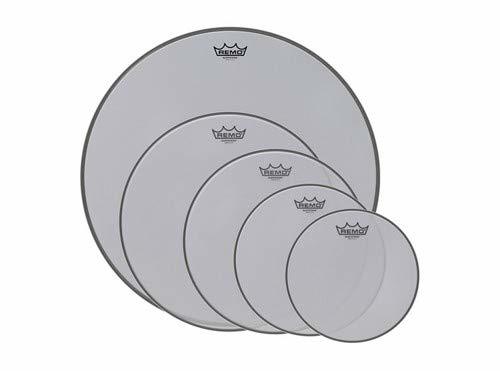
Remo Silentstroke (view item on Amazon) (commissioned links)
These mesh drum heads feel almost like the real thing but they are inconvenient in that they are a drum head so you have to switch out your regular drumheads on the kit with these. If you have an extra practice kit or even a tom and a snare, you can just leave them on those drums for practice.
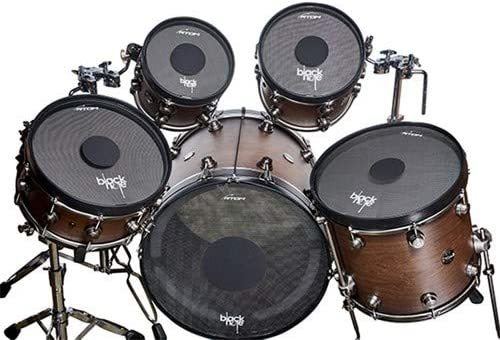
RTOM Black Hole Practice System (view item on Amazom) (commissioned links)
The Black Hole Practice System is a newer product similar to the Remo Silent Strokes but they easily clamp onto the rim of your drum without having to remove your drumhead. They claim to bring down the volume by 80% and boast that the feel is better than any other option. They are a bit more spendy but the simple setup can outweigh the cost! They offer this entire kit or single pads. I have not used these but I have gotten numerous suggestions to add this to this article!
These cymbals are probably the best option out there because they feel amazing. Switching these cymbals out isn’t that bad either. Using the Zildjian Low Volume Cymbals in combination with the Remo Silent Stroke is my favorite option. For quick swapping, use the Zildjian Low Volume Cymbals along with the Vic Firth Drum Mutes.
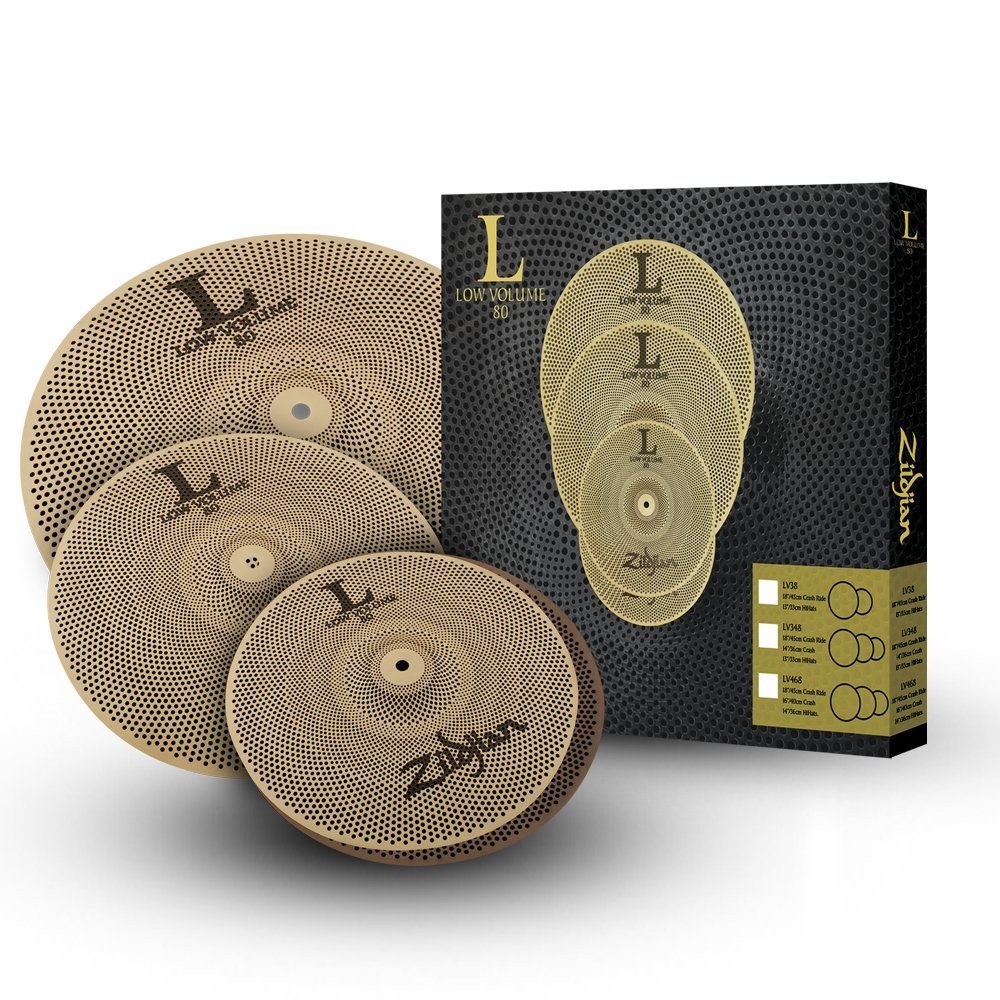
Zildjian L80 Low Volume Cymbal Set (view item on Amazon) (commissioned links)
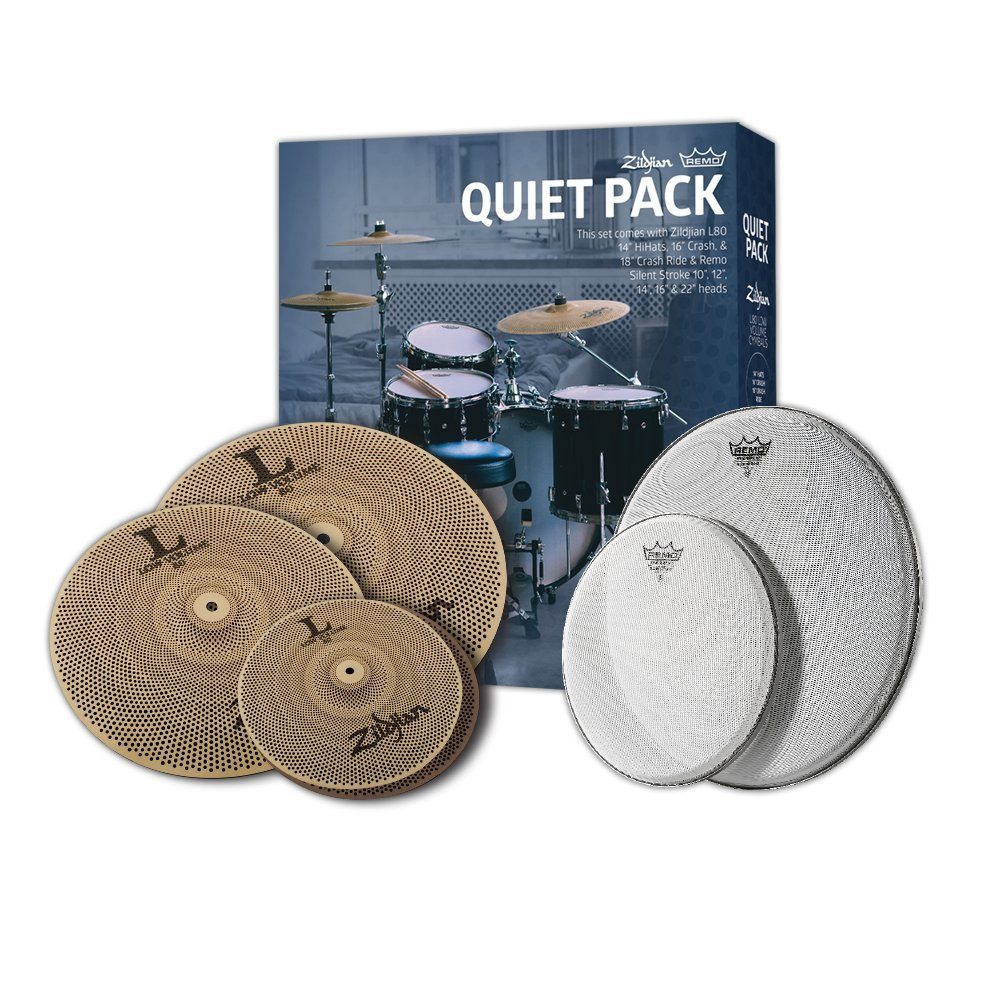
Quiet Pack - Zildjian Low Volume Cymbals with Remo Silentstroke (view item on Amazon) (commissioned links)
Electronic Drum Kits
Obviously E-drum kits are a great option but they can be expensive. They play just like rubber or mesh pads but, with headphones or speakers, sound like a professionally mixed drum kit. Some can also have built in metronomes and songs to practice with. There are so many out there so I will break down some of the best ones in different price ranges.
As with my disclaimer earlier, e-drums can also feel a bit different than real kits. They will create a beautiful sounding drum kit when you hit the drum regardless of whether you are using good technique. When switching to a real kit, it might take some adjustment to create a good sound on an acoustic drum (ie. good rebound, clean strokes, etc.). Keep that in mind.
The drum heads are usually made of rubber or mesh with a sensor inside to sense the hits. You can tune the mesh heads to have a tighter feel giving you an easier bounce. The rubber pads tend to have a harder surface than regular drum heads. This will prove difficult when you switch to a real drum set where the nicely tuned drum doesn’t have the same rebound you were used on the mesh or rubber pad. Another thing to note!
Note: Roland and Yamaha hi-hat pedals are not interchangeable! Without getting technical, the technologies basically work in opposite ways. Something to note when adding on to your kits or piecing together used pieces of equipment!
Roland
Best

Roland TD 25-K (view item on Amazon) (commissioned links)
These are high end electronic kits and they have all the features you would ever want to perform with very realistic sounds. The sound module is a simplified version of the TD-30 and it’s really easy to use. It doesn’t really have any of the experimental sounds on it because it’s focused on being a traditional drum set. The drums have mesh heads that can be tightened/loosened to feel like a real drum. The cymbals sit on a stand just like a real cymbal and naturally sway when struck. They allow chokes (grabbing the cymbal for staccato hits) and have 3 zones so they can provide 3 different sounds depending on how you hit them. You can record your own performances right onto the module so you can assess your performances and share them with drum teachers, friends, etc.
Some have said that the rack is a bit small for setting up but I think it works just fine. I like to have the lightest and smallest hardware possible in case I have to set up on a tight stage. As with most setups in apartments, the heavy hi-hat ‘cymbals’ seem to thump the floor a bit more than desired. You can remedy this by putting a rubber pad down or switching to a lighter cymbal style pad.
It’s worth mentioning that this particular kit does not come with some essential items: drum throne, kick pedal, hi-hat stand, headphones, and drum sticks. These are generally personal items that drummers can be particular about so it is left up to you to decide on the brand/types of these that you want.
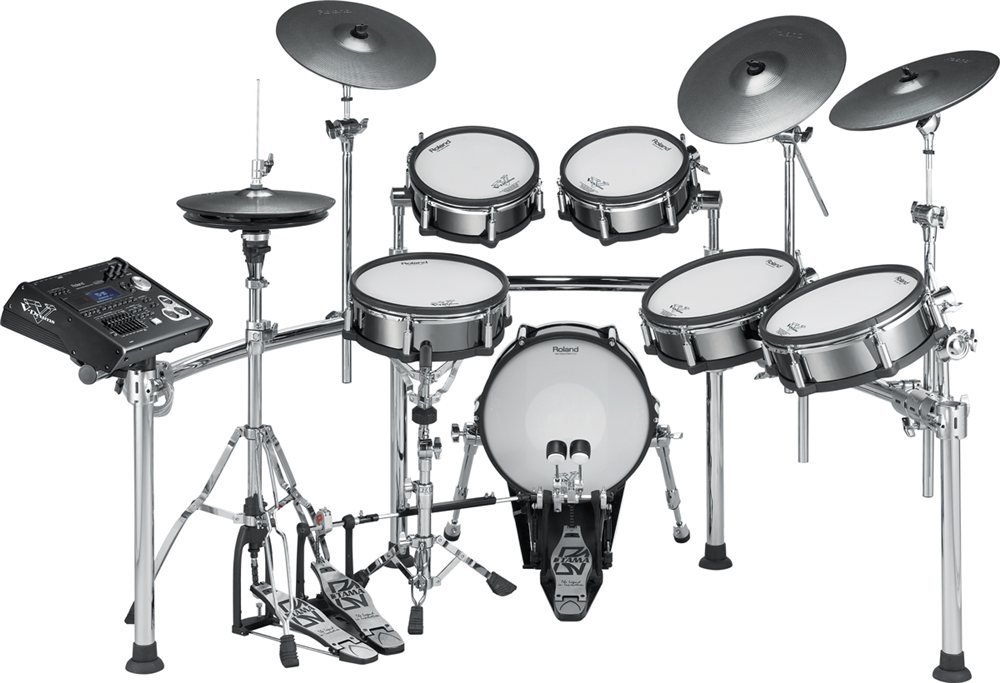
Roland TD30-KV (view item on Amazon) (commissioned links)
This monster literally has everything. Of course, it’s really expensive, but it’s the best. It has every feature of the TD-25KV and even a bit more. The hardware is better. Some of the drum and cymbal pads are better. The hi-hat cymbals are less clunky. The drums look like real drums despite the fact that they are e-drums. The module contains all kinds of extra sounds of which you can tweak. Again, this one does not contain the "personal" items such as the kick pedal, hi-hat stand, snare drum stand, throne, sticks, and headphones. Every e-drum loving drummer would love to have this kit but it is a bit too expensive. I would personally rather build a soundproof room (look below!) and use an acoustic kit!
Not Too Expensive But Worth It
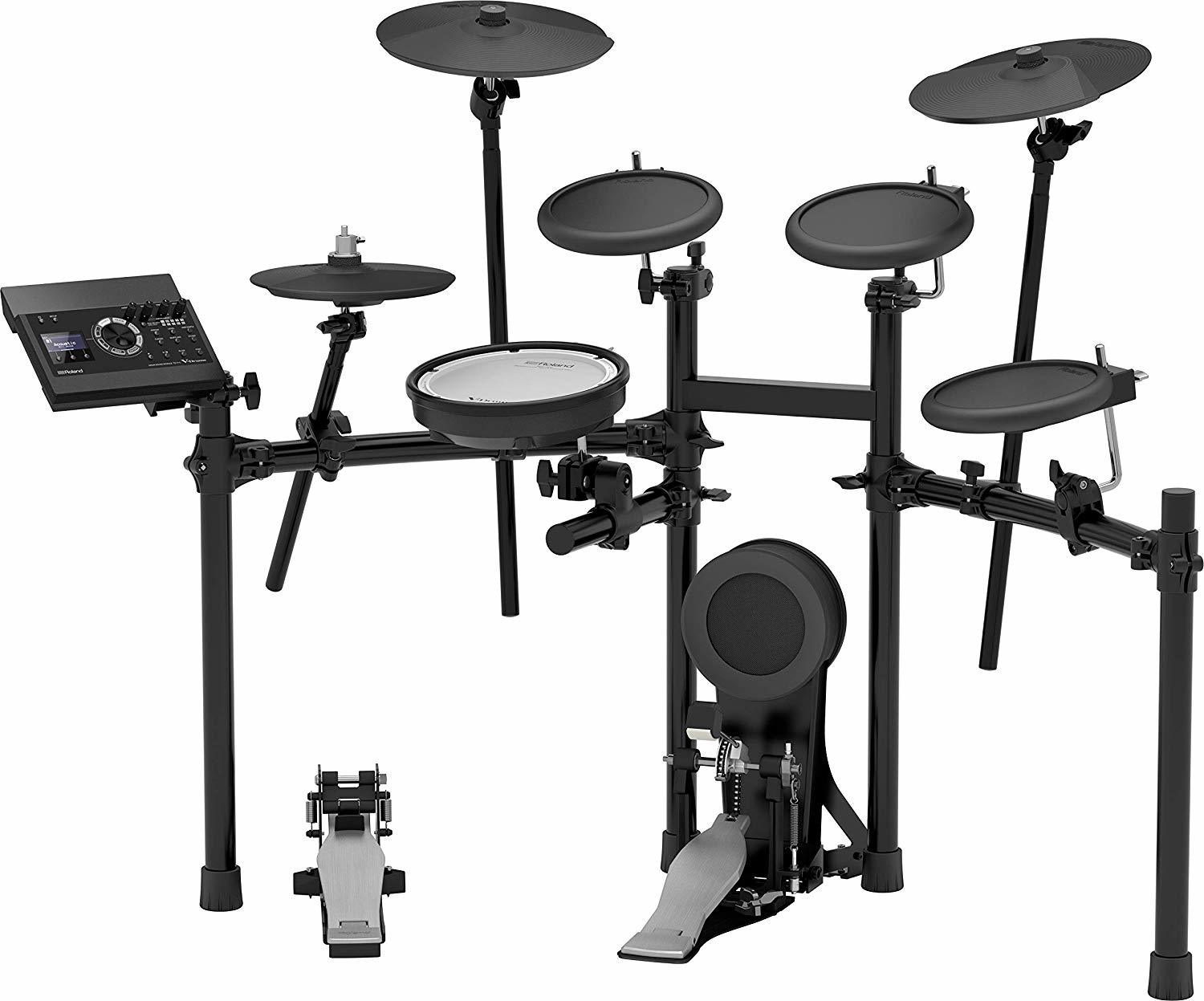
Roland TD-17KL-S (view item on Amazon) (commissioned links)
If this price point works for you, you won’t be disappointed. This kit has many features you get on the nice kits but simplifies everything. It has the play-along features, click track, recording, etc. The module has some basic but great sounding kits to choose from. The only mesh pad you get is the snare drum pad, the rest are rubber. They are still responsive but you don’t get as good of a feel as you can from the mesh pads. The cymbals have 2 zones so you won’t get to hear a ride cymbal bell sound.
If I was buying a starter kit or a second practice kit and I didn’t want to disturb others with the noise, this is the one I would go with. Anything less, you will miss some quality and features, and anything more would be too expensive for what you’re using it for. You could still perform with this kit as well.
This particular one has some options on Amazon to add cords, sticks, headphones, etc. Remember though, you need a throne and kick pedal and possibly some other items depending on which package you select!
Beginner
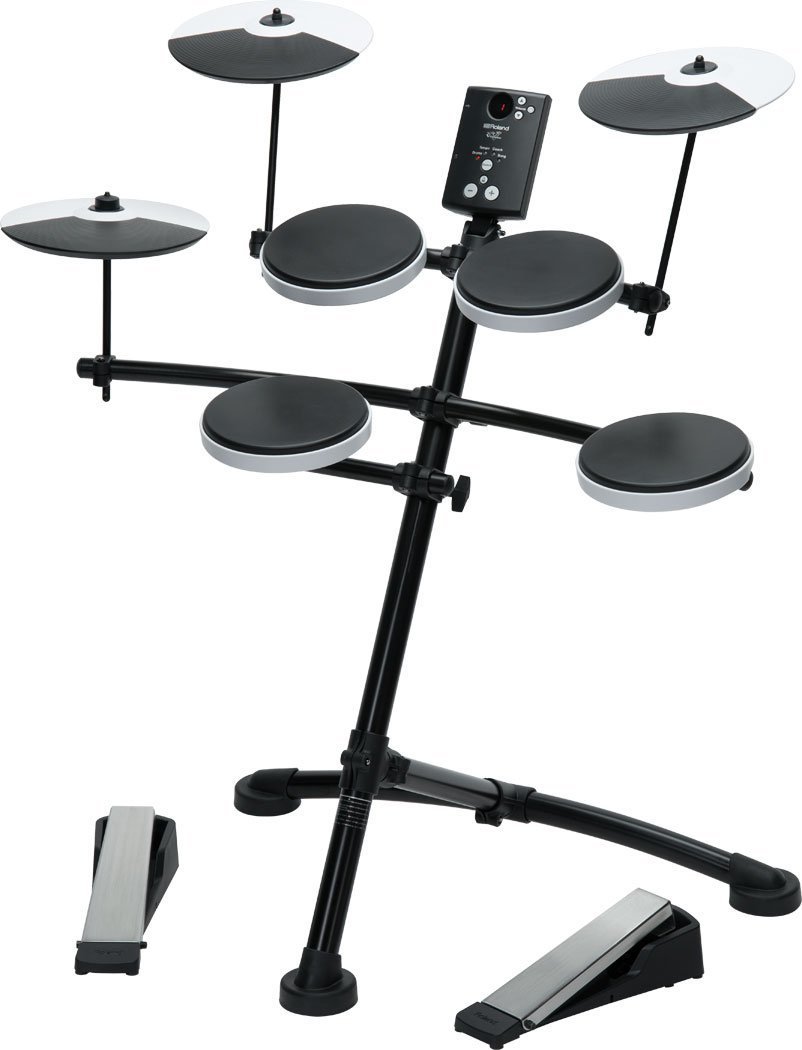
Roland TD-1K (view item on Amazon) (commissioned links)
This is an awesome beginners kit. The price is great and the quality surpasses the price. The module has 15 basic preset kits but they sound really great. You can’t tweak them like you can with the higher end kits but they definitely work from a practicing standpoint. The pedals that come with the kit are very basic and they leave a bit to be desired. The kick drum does not have a beater, just a sensor when your press down the pedal. This kit will feel quite a bit different from the higher end kits or real acoustic drum sets. I have heard of some people gigging with these but I’m on the fence about that. It is, however, super durable and lightweight.
You would only need to pick a throne, sticks and headphones to get rolling with this kit!
Yamaha
Not Too Expensive But Worth It

Yamaha DTX532K with Accessories (view item on Amazon) (commissioned links)
Yamaha’s technology seems to rival just fine with Roland’s. This particular kit comes with everything you need to start playing including the throne, kick pedal, stands, and headphones. The cymbals are great because they support muting and swells. All the drum pads are silicone except the bass drum. With a rubber bass drum head, it might cause a bit of thumping in a 2nd floor or higher apartment. This is something you could upgrade later by buying a mesh bass drum pad. Only Yamaha’s expensive kits come with the mesh bass drum pad. It’s worth mentioning that there are apps you can use in conjunction with the Yamaha e-kits for recording, practicing, or just navigating the menus a bit easier.
Beginner
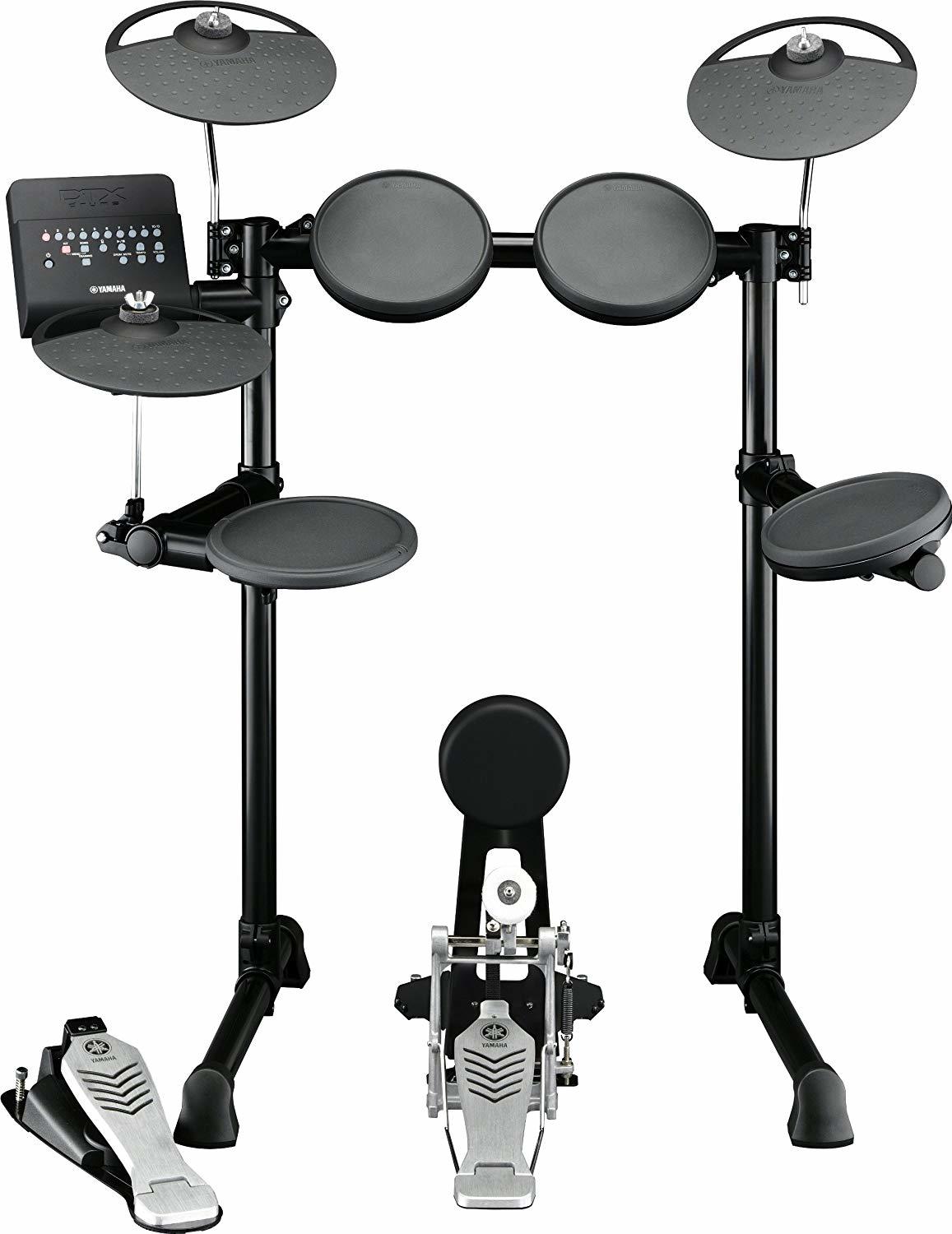
Yamaha DTX450K (view item on Amazon) (commissioned links)
This one has a real kick pedal which goes a long way on a beginner kit. The price is still a little high for a beginner kit though. It’s pretty basic with rubber pads for all of the drums and cymbals. The snare does have 3 zones which allows for rim shots and side stick sounds. I think this one falls short on the cymbals and hi-hat. The hi-hat pedal won’t feel like the real hi-hat on the DTX532K and the cymbals only have one sound—no choke or swells. Again, this one is great for a beginner and the Yamaha line is really great with adding on and upgrading.
I would urge you to check out Yamaha’s homepage for their own comparison chart of all of their e-drum kits. You can go in depth to find exactly what you want out of your kit. Just go here:
Yamaha (USA) E-Drum Kit Model Comparisons
Alesis
Beginner

Alesis Nitro (view item on Amazon) (commissioned links)
I found the price point on this kit to be the most intriguing. Their higher end kits just don’t compare to the Roland or Yamaha kits. For a kit at this price coming with all mesh heads, it’s quite a deal! One thing to note: it does not come with a throne! The pads feel really nice and the sounds are great. But, it always seems a little more difficult to dial in the right response settings on these Alesis kits. You can tell the pads aren’t the same high quality as the Rolands or Yamahas.
Other Beginner Option

Carlsboro CSD120 (view item on Amazon) (commissioned links)
If you are looking for the most simple and inexpensive option to practice quietly, then this is it! This one does NOT come with a throne though. It’s very compact and has some good sounds that can definitely get you practicing. I would not suggest gigging with this kit.
Soundproofing & Treatment
If the muting and practice pad options don’t cut it for you and the e-kits don’t intrigue you, there’s always sound proofing and treatment. You can do as little or as much as you need to get the sound quieter depending on what your needs are.
Sound Treatment
Sound treatment can help a bit more than you might think. Simply placing foam pads across the walls might just be enough to kill the sound. Just buy some foam pads and glue them to a piece of cardboard or a thin piece of plywood and hang them like a picture. Center them on every large flat wall surface. These will help with the sound inside the room too if it is too lively and/or echoey. This is the best deal I found and you can buy these in packages with different amounts depending on how many you need.

12 Pack Acoustic Foam (view item on Amazon) (commissioned links)
Another helpful technique is hanging some foamed frames directly above your cymbals. This will really settle the cymbals down and help drastically inside the room as well. They have to be at least 2’ x 4’ (24 inches x 48 inches) to cover the entire length of the drum set.
I hung up some homemade frames stuffed with foam and wrapped with cloth. These can also be mounted on the wall as well and they look a bit more attractive than the foam pieces glued to plywood or cardboard. You can build them or buy ones like these online for around $50 a piece. These particular panels comes in 3 different colors.
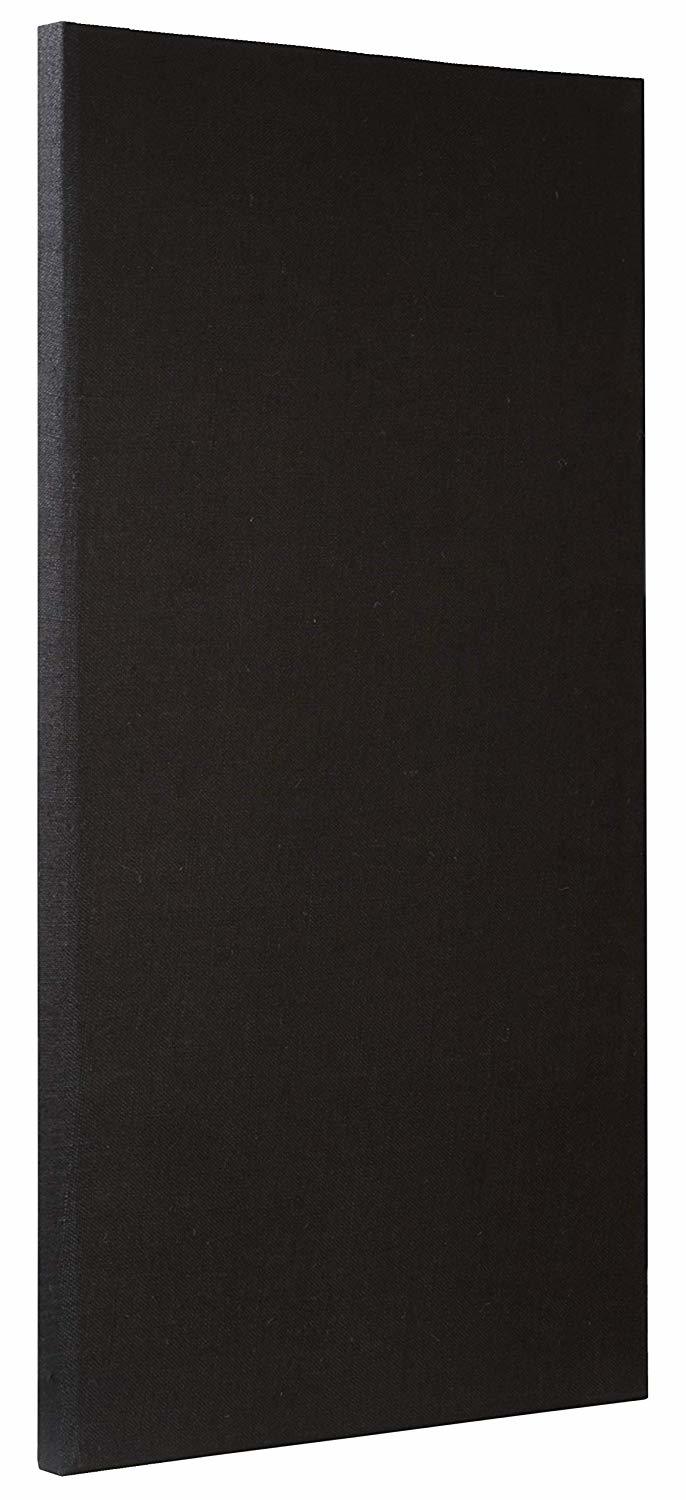
ATS Acoustic Panel (24"x48"x2") (view item on Amazon) (commissioned links)
I measured out the frames and put eye hooks on the ceiling and on the corners of the frames. Then I tied some string to suspend them about 8 feet above the ground where you drum set sits. Hopefully they hang at least 6 inches off the ceiling to allow them to trap reverberant sound in-between the frame and ceiling.

Here’s some instructions on how to build your own panels:
•How to Build Your Own Acoustic Panels at AcousticFreq.com
Soundproofing Windows
Windows can be the main culprit in letting sound escape. I would suggest hanging a vinyl cover or soundproofing blanket like these here. Trademark Soundproofing make some really nice window soundproofing products but they are very expensive—like $300! These here are more in the $100 range.

Audimute Sound Absorber (view item on Amazon) (commissioned links)
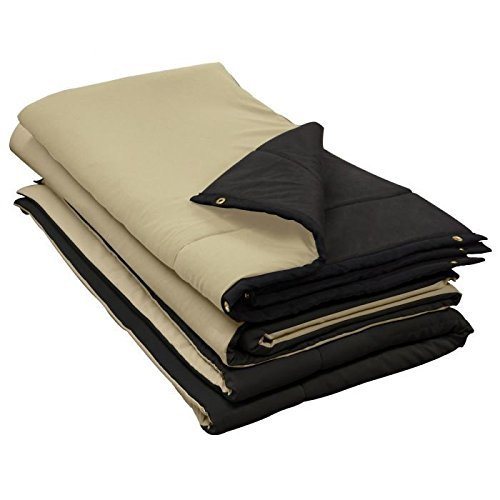
Audimute Sound Blanket (view item on Amazon) (commissioned links)
Soundproofing Walls
The options for soundproofing your walls range from relatively inexpensive to very expensive. There’s a lot of planning that would have to go into your project, assuming you’re handy enough to do the job yourself. Doing drywall can be a difficult job if you don’t know what you’re doing! Hiring out the work isn’t a bad idea as well if you want it done timely and efficiently.
For the more modest and less expensive option, you can use regular pieces of drywall along with this product called Green Glue Compound. Essentially what you’re doing is adding another layer of drywall and putting the green glue in between the old drywall and the new drywall. Then you can re-trim and paint the wall. It’s much easier said than done!

Green Glue Compound & Sealant Combo Pack (view item on Amazon) (commissioned links)
You could also upgrade those pieces of drywall to soundproofing drywall. A regular piece of 4’x8’ drywall can cost as little as $7.50 versus a 4’x8’ piece of soundproofing drywall can cost about $55. You need 2 tubes of green glue per 4’x8’ sheet of drywall which cost about $20 per tube. You can get better pricing if you buy packs of tubes or 5 gallon buckets. There is also a “sealant caulk” which is used on the perimeter of each piece of drywall. One tube of the sealant covers about 50 linear feet for $20. There are packs of the compound and sealant together to help you save a little bit of money.

Green Glue Compound - 5 Gallon Bucket (view item on Amazon) (commissioned links)
There are also vinyl soundproofing rolls that can be applied over studs, joists or in suspended ceilings. I have never tried these myself but if you are doing this yourself, I have heard that the rolls are extremely heavy and bulky and difficult to install because of their weight.
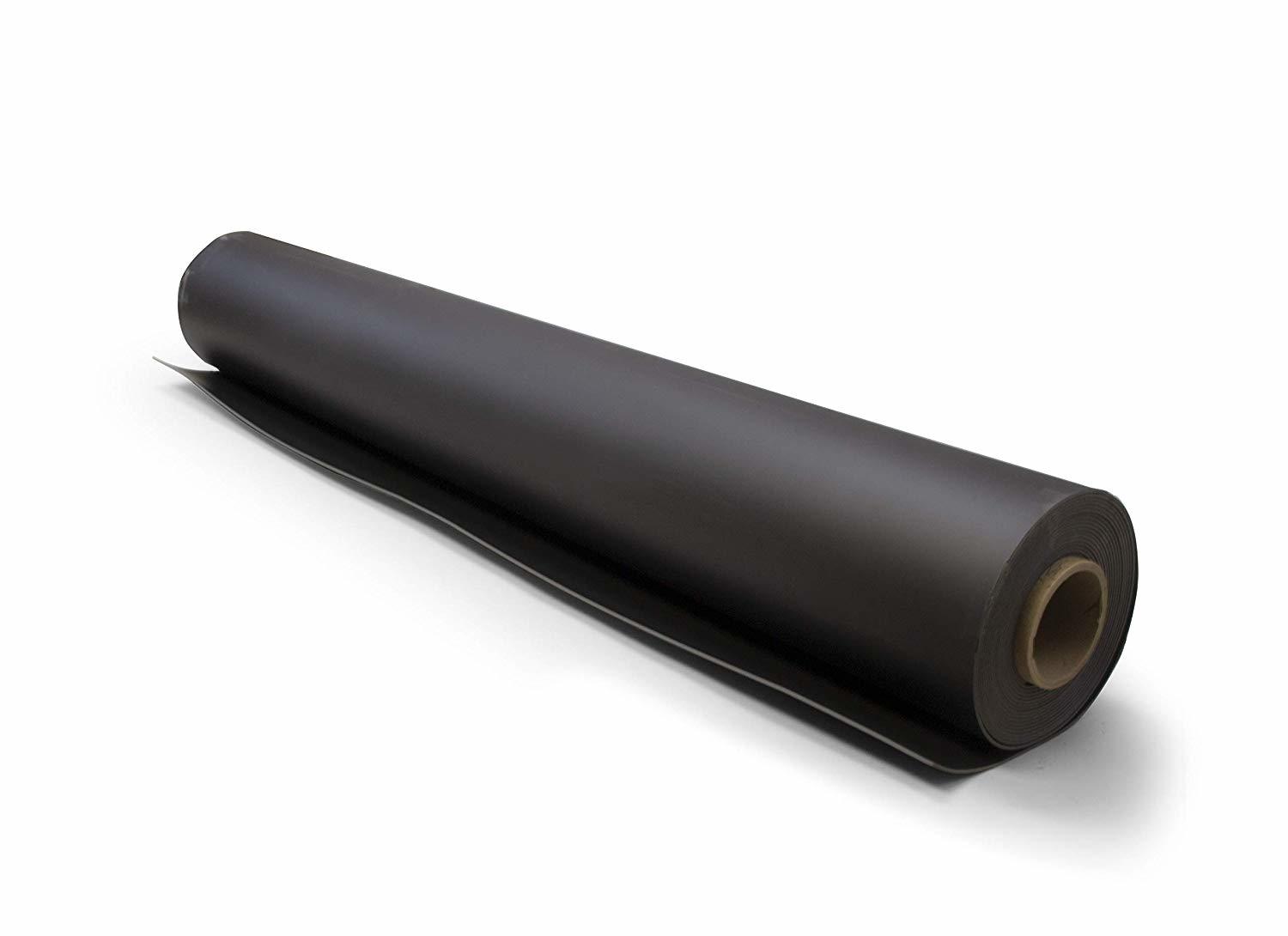
Soundsulate Vinyl Roll (view item on Amazon) (commissioned links)
So what would it cost?
If you hire out the work, drywalling a typical 12’x12’ room without the sound proofing products would cost about $600-$800. You would want to make sure you do the ceiling or floor as well depending if you are in a basement or an upstairs room. You could estimate by adding the cost of the green glue compound at about $400 and the sealant at $200 plus the added labor equalling about $800. If you want the soundproofing drywall, you would add another $600. So a very rough estimate would be about $2500-3000 for a thoroughly soundproofed 12’x12’ practice room. That’s still cheaper than some of the high end e-drum kits!
You can definitely save anywhere from $1000-$1200 in labor if you want to do it yourself. I am handy and like to do a lot of these DIY projects myself but I don’t feel comfortable giving my own directions on how to do this. Here are some resources that I would use for this DIY project.
•Soundproofing at TheSpruce.com
•Hanging Drywall at Homeadvisor.com
•Green Glue Installation at GreenGlueCompany.com
Soundproof a Ceiling
Soundproof a Floor
Soundproof a Window
So that's it! I've given you every option that I found effective to allow you to practice your drums without bothering anyone! And now that you are able to practice...time to get at it! And when you're ready to organize your practicing in a way that's most effective, check out my two part article:
Definitive Drum Practice Guide from Beginner to Advanced - Part 1 - Scheduling and Gear
Definitive Drum Practice Guide from Beginner to Advanced - Part 2 - Practice Session
As a member of the worldwide drum community, please share this to support me and I will do the same for you!
**Full Disclosure: I earn a commission if you click any of these links and make a purchase, at no additional cost to you.**
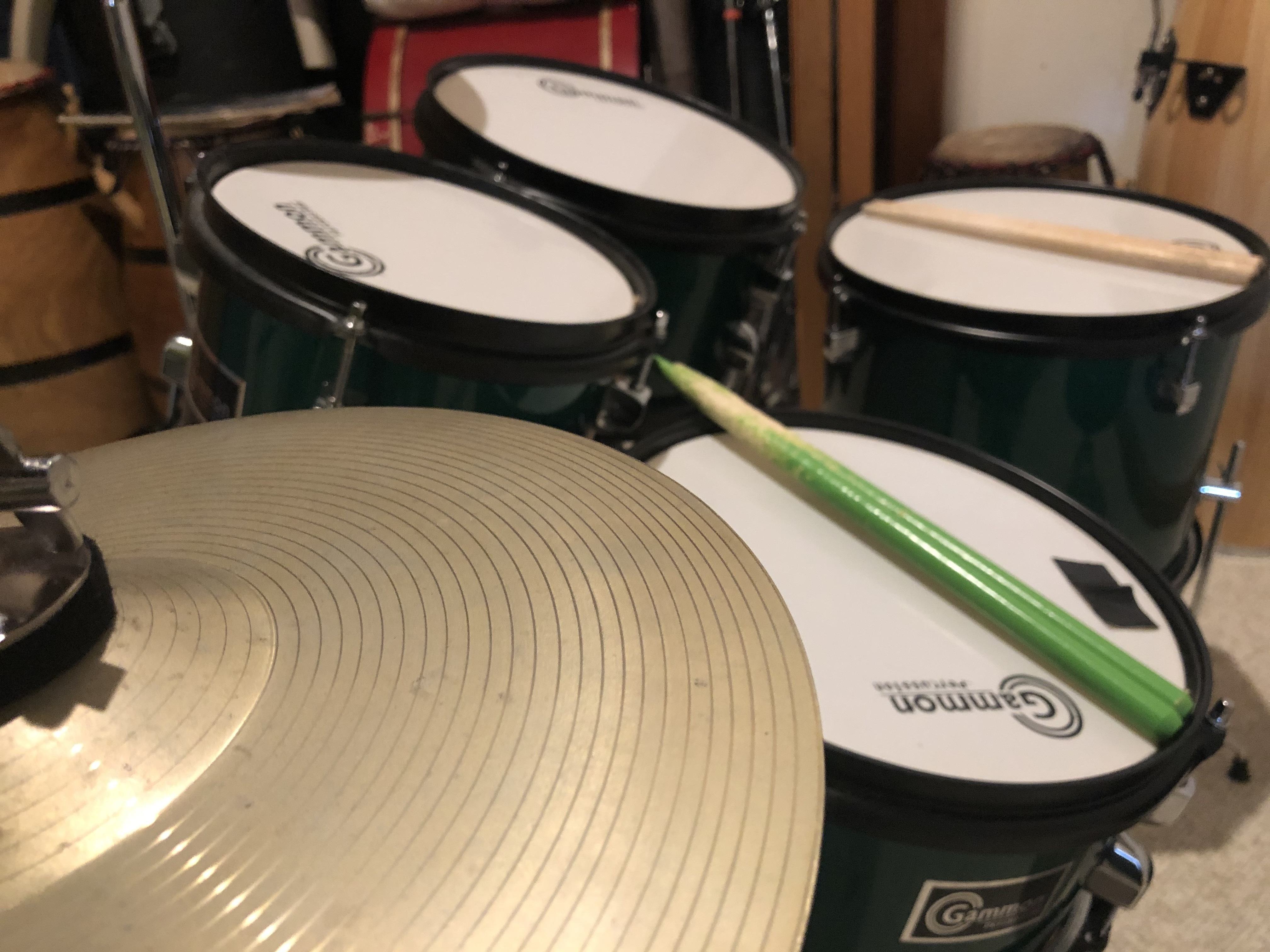
I love to see the excitement in a child when they decide they want to do something new...like taking up drumming. I have a young son myself and he loves drumming. I taught him a whole summer of lessons and now he thinks he knows it all! Ha! But, there are a few things that I was able to set him up with so he had the right tools to start learning.
I'm going to go over everything your child would need to get started in drums or percussion. This would cover drum sets, sticks, lessons, books, pads, metronomes, etc. I am specifically writing this for my own new students but I know this will help other parents too. This article covers kids from ages 5-10. If they are older, take a look at my other article that covers ages 10 to adult: Definitive Drum Practice Guide from Beginner to Advanced - Part 1 - Scheduling and Gear.
I always say that the age of five is probably the youngest a child could start learning drums. Of course, that depends on how much they are able to focus. Some kids at 5 years old can't focus at all while some can focus for at least 20-30 minutes. This is a relatively normal attention span with how most kids develop. My son didn't try lessons until he was 6 and it was a struggle for him to focus longer than 10 minutes. It would be safe to say that any child 8 years old and up would be ready to start learning drums.
I have an opinion about “lessons vs. self-taught” that I would like to explain so I can help you decide on whether they should get lessons or not.
When you self-teach, in any subject or discipline, it only takes you longer to reach your goals if you do it without the direction of a teacher that has already reached similar goals. I understand that everyone learns a bit differently, but as long as you have a good teacher, they will always find a solution faster than you can. Otherwise you're just taking shots in the dark to try to figure out techniques, licks, etc.
Bottom line is, good teachers will always help you reach your goals faster. At a younger age (younger than 12), it is almost imperative to get them lessons. There aren't a lot of children that would be able to learn drumming without some direction to start with.
This is the big question here. How far do you think they will go? Do they seem dedicated enough to invest in a drum set? That is going to have to be the question you ask yourself. Obviously there are drum sets of all sizes and colors. But you don’t need to start out by spending $800 on a drum set. You could start out with a beginner's drum set, practice pad, or percussion kit. This would get them started practicing techniques like single stroke or double stroke rolls. Even learning to hit a drum properly can be tricky at first. In this section, I will cover all types of options ranging from cost effective to higher end. One thing to remember, when you start buying adult sized, medium quality kits, they don't come with cymbals, pedals, or thrones (drum seats). Decent cymbals are almost always sold separately from drum sets and can range anywhere from $200-$500 for one cymbal!
I bought my son this Gammon Drum set when he started showing a lot of interest. For the price, it's great. The cymbals could be better but I still thought it was worth the price. The drums sound pretty good and they are tunable. The cymbals could be upgraded at a later time if the student continues to stay interested. Cymbals can be expensive so buying them later can help get your child started while keeping the cost down. This set comes in a few different color choices as well.

Gammon 5-Piece Junior Starter Drum Kit with Cymbals, Hardware, Sticks, & Throne (view item on Amazon.com) (commissioned links)
If you wanted to step up the quality in the drum set, you could take a look at this Ludwig Questlove Pocket Set. Buying a name brand will help a lot with resale value if they happen to lose interest. I will say with this kit as well, the cymbals still aren't much to be desired. However, this kit can be grown into and upgraded a bit easier than the previous kit, and it will last longer too. There are a few colors to choose from on this kit as well!
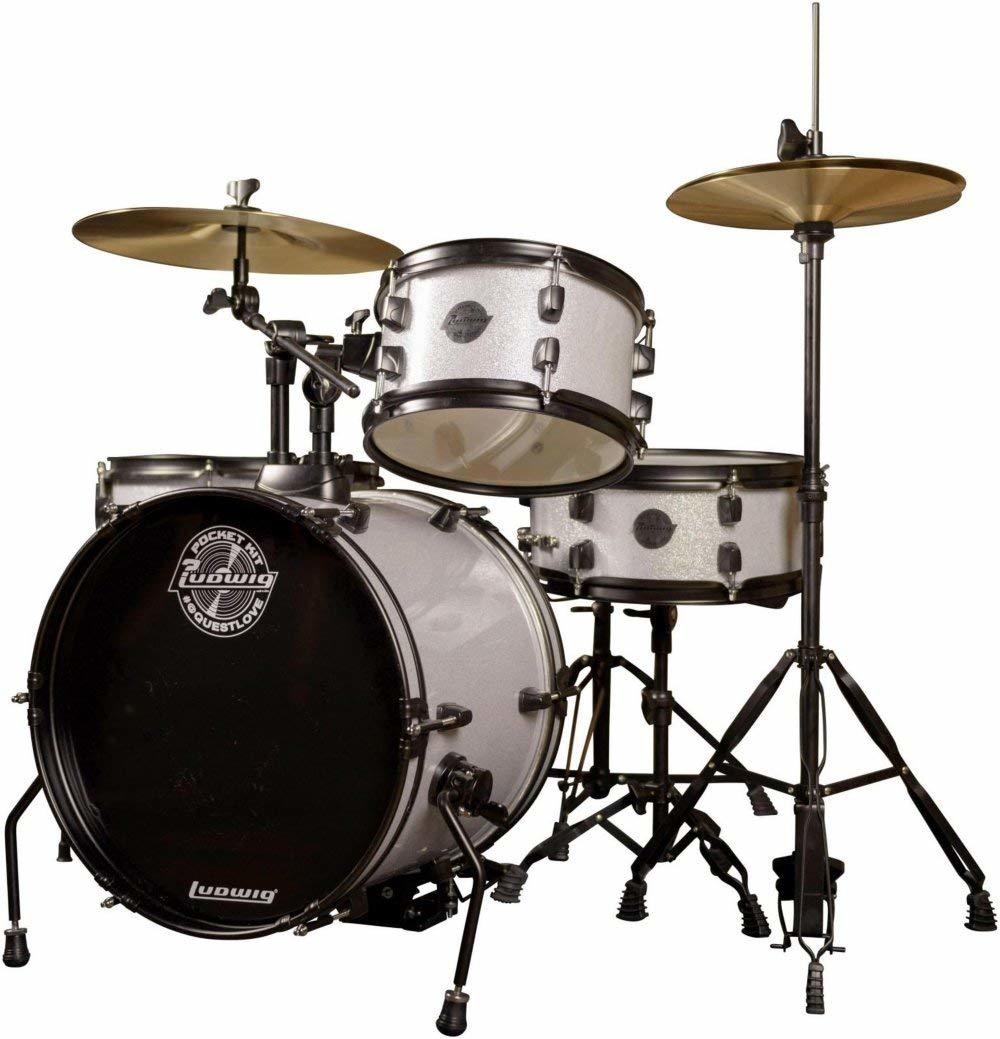
Ludwig LC178X016 Questlove Pocket Kit 4-piece Drum Set (view item on Amazon.com) (commissioned links)
If you want to support your child's interest in drums, and keep your neighbors in good standing with you, you might want to look at an electronic drum set. These can be virtually silent when played but heard in headphones or controlled by volume through speakers. It has a built in metronome and other practice tools right in the module and a bunch of sounds sounds to play with. I do have to mention that nothing can replace the sound and feel of a real acoustic drum set. Learning on a electronic drum set can be good for a while but eventually, they will need to learn techniques that are difficult to replicate on an electronic drum set.
This Alesis Turbo kit is very affordable and comes with everything you need including sticks and headphones. The sticks might be a bit too long for a smaller person but I have some other options listed below.
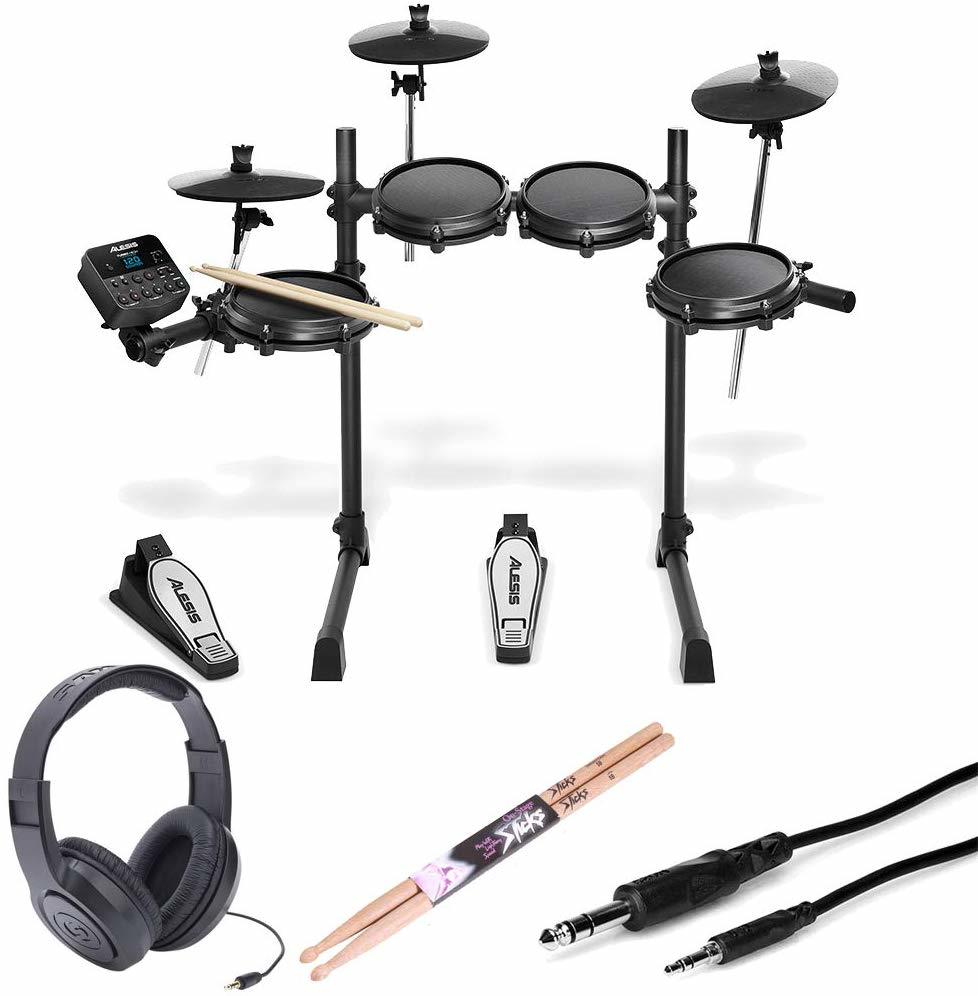
Alesis Turbo Mesh 7 Piece Electronic Drum Kit With a Pair of Drum Sticks + Samson SR350 Headphones + Hosa 3.5 mm Interconnect Cable, 10 feet - Deluxe Accessory Bundle (view item on Amazon.com) (commissioned links)
If you wanted to upgrade or buy a package with a speaker, you can take a look at this Alesis Nitro kit with a speaker included.
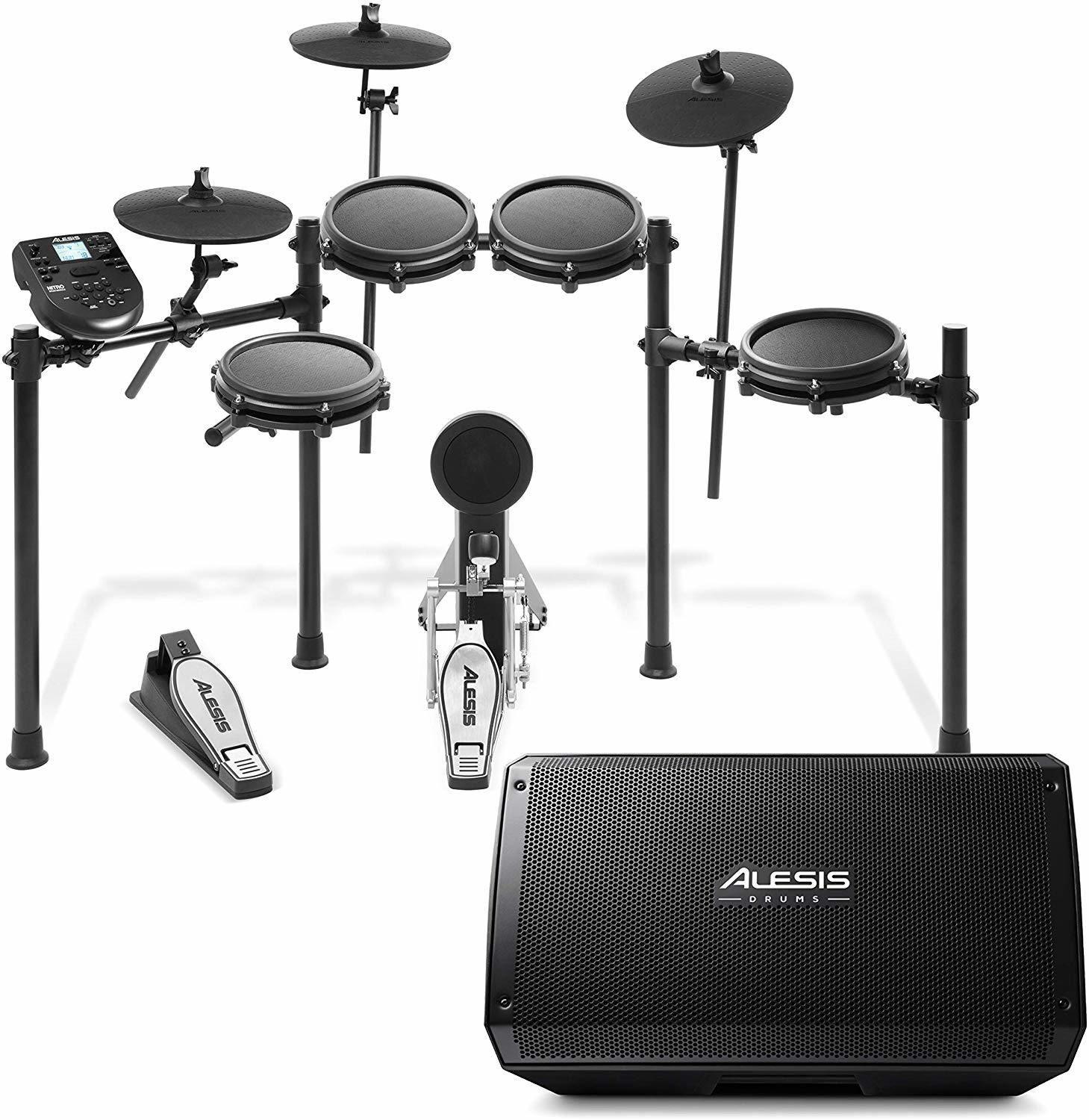
Alesis Nitro Mesh Kit + Strike Amp 12 | 8-Piece All-Mesh Electronic Drum Kit Bundled with 2000-Watt Ultra-Portable Powered Drum Speaker/Amplifier (view item on Amazon.com) (commissioned links)
For around $20, you can get a practice pad and work on almost all the drumming techniques they will need in order to sound good on a drum set. And your student will always need a practice pad. I have three myself and I use them all the time. They can use them for warm-ups backstage before performances, late night practice when they can’t be loud, practicing on a beach, or on the john! They’re smaller and easier to transport than a drum set!
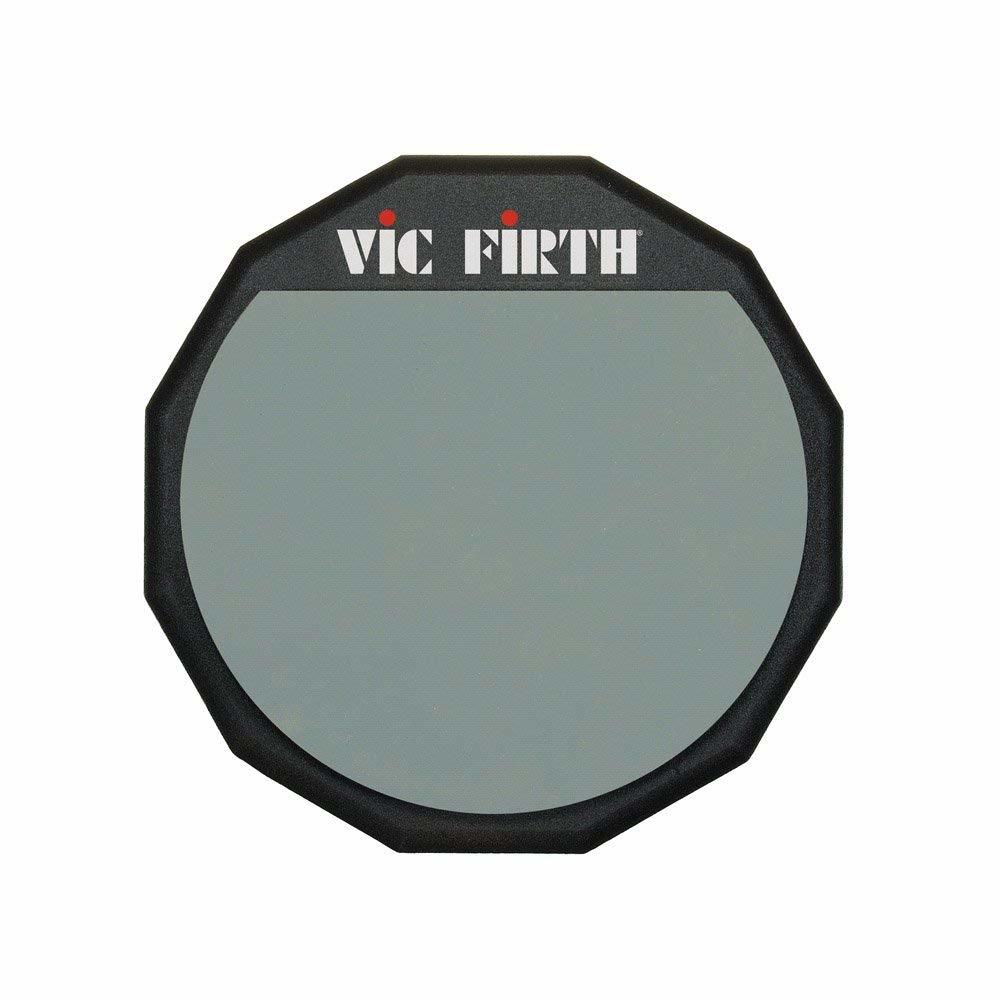
Vic Firth 6" Single Sided Practice Pad (view item on Amazon.com) (commissioned links)
When a student joins the school band, a lot of schools require that you purchase a percussion kit. This is a kit that includes sticks, practice pad, bell kit, mallets, and a multi purpose stand. I would highly suggest getting a good quality one for two reasons. First, the cheap ones are really bad and will fall apart before school years end. Secondly, the resale value on a brand name kit will not go down by much. It will sell without trouble because people are always looking for these.
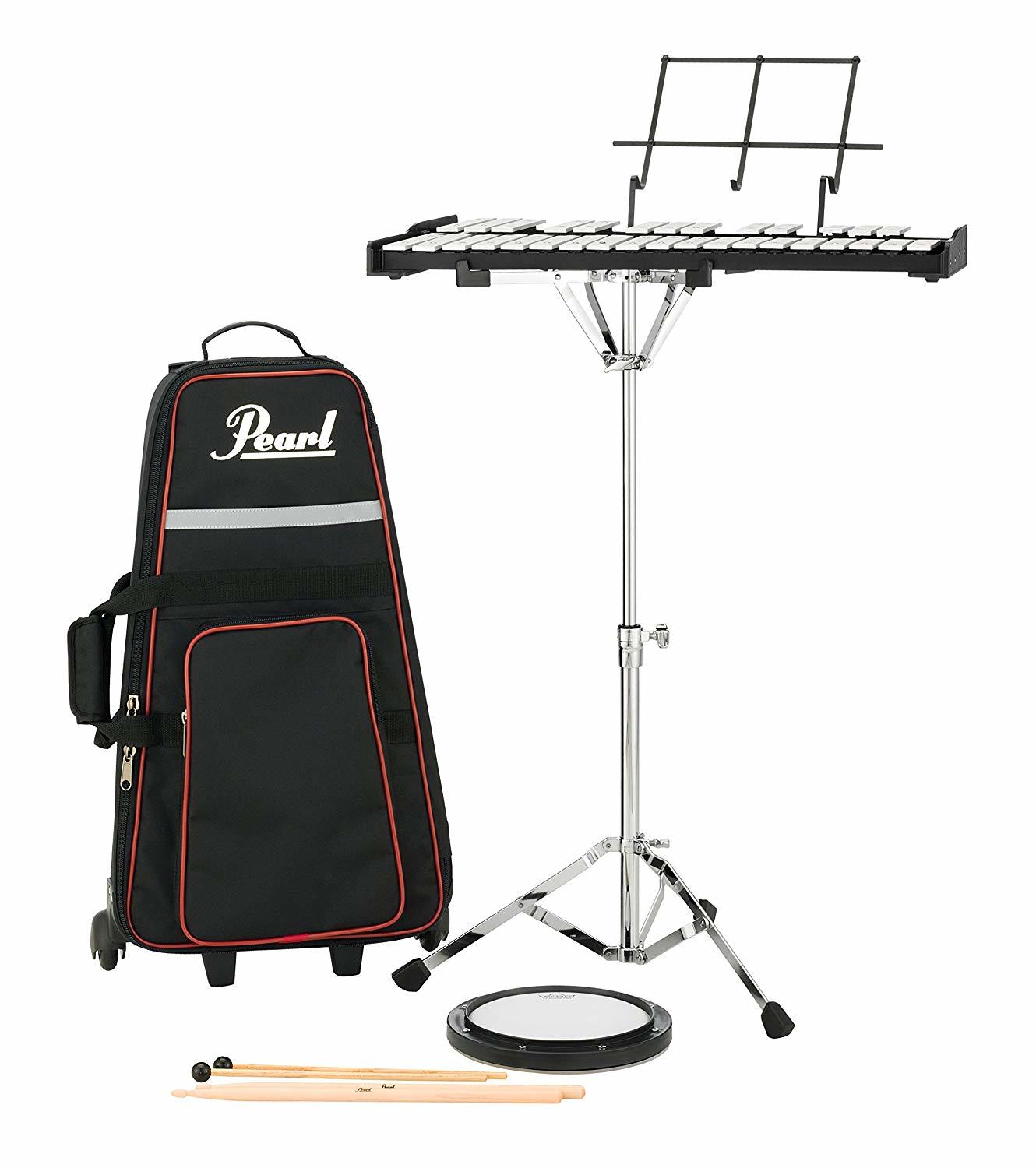
Pearl PK910C Educational Bell Kit (view item on Amazon.com) (commissioned links)
Every drummer needs drumsticks, but what kind? There are literally hundreds of different types of drumsticks. At this age, the length and weight are the most important because standard/adult sized sticks might be a bit heavy. A lot of kids like to get sticks with their favorite characters or band on them. As long as the drum sticks are about the length of their forearm, it should work well for them. I like these Vic Firth Kidsticks, they come in blue or pink.

Vic Firth Kidsticks (view item on Amazon.com) (commissioned links)
For kids under 12 and have joined school band or a community band, then the Vic Firth SD1 Jrs. are what you'll need. They are a bit bigger than drum set sticks but they work better for concert snare drum and tom work.

Vic Firth American Custom SD1 Jr. Drumsticks (SD1JR) (view item on Amazon.com) (commissioned links)
One item that musicians overlook is a metronome. This is an essential practice tool for any musician. A metronome is a small electronic device or a phone app that makes a “click” noise at a perfectly constant speed that you set it to. The clicks are measured by “beats per minute” or BPM. For the math junkies, a metronome set at 60 BPM will click 60 times in one minute.
Almost all music is set to a constant pulse and it is essential for all musicians to have a solid internal pulse that doesn’t speed up or slow down (unless intentional). The only way to practice your internal pulse is to practice along to a metronome set to a perfectly constant tempo.
As a drummer, it is a bit more difficult to practice with a metronome because our instrument is naturally loud. And, as a beginner, it is difficult to control the volume at which we play. So, a lot of metronomes are too quiet to hear while we practice with them. The solution is to get some sort of an in-ear monitor or headphones. This helps block the outside sound allowing us to hear the click.
There are many metronome apps available on our phones that are free. If you go that route you could get these sound isolation headphones: Shure SE215-CL Sound Isolating Earphones. Or, you could use other headphones you already own for the time being but they might not provide very much isolation. Otherwise, you can purchase this ‘all-in-one’ in ear metronome: Korg In-Ear Metronome.

Shure SE215-CL Sound Isolating Earphones (view item on Amazon.com) (commissioned links)
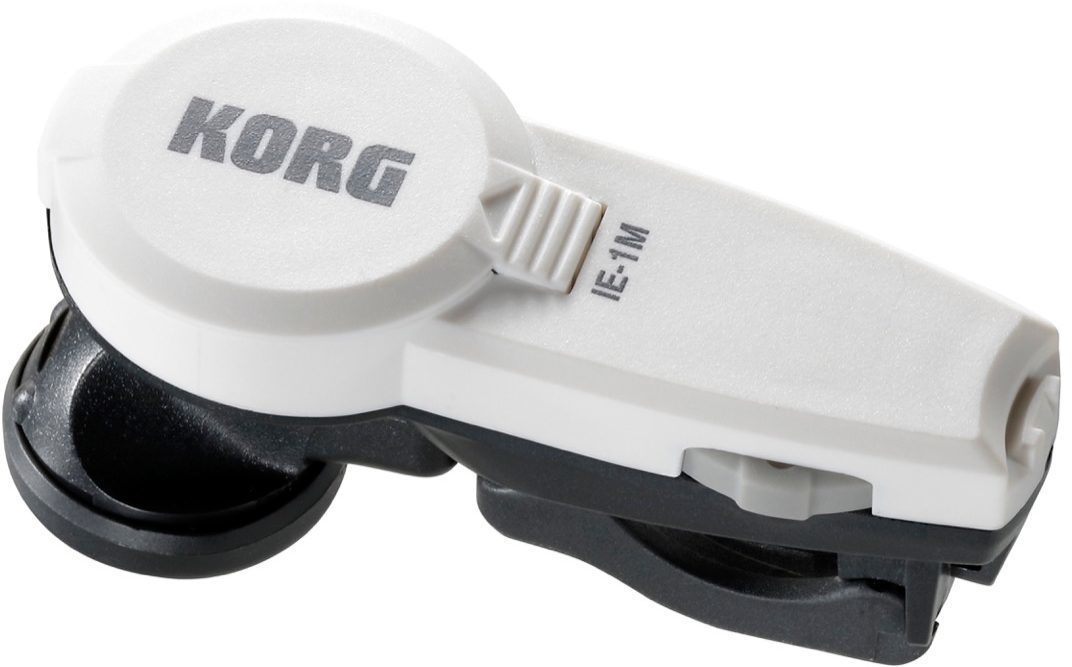
Korg IE1M In-Ear Metronome (view item on Amazon.com) (commissioned links)
This is the one book I go to as the definitive starting drum set method. Alfred's Beginning Drumset Method is perfect. It starts with reading music and rhythms, holding the sticks, and playing basic rock beats and eventually moves along to more advanced beats and a jazz section in the second half. This is the book I started with myself!
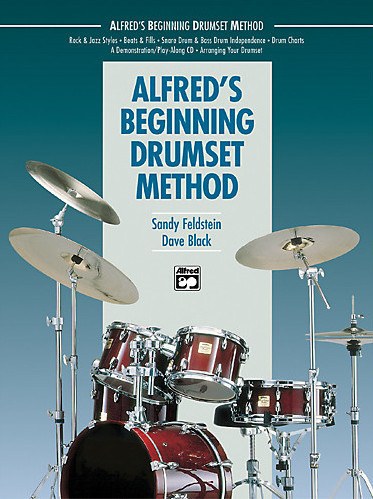
Alfred Beginning Drumset Method Book with optional CD (view item on Amazon.com) (commissioned links)
And with that, I think your little beat maker is ready to get started! Don't hesitate to email me with any questions!
As your student moves along, I would strongly suggest reading my two part series on practicing. The links are right here:
Definitive Drum Practice Guide from Beginner to Advanced - Part 1 - Scheduling and Gear
Definitive Drum Practice Guide from Beginner to Advanced – Part 2 – Practice Session
Thanks for reading!
**Full Disclosure: I earn a commission if you click any of these links and make a purchase, at no additional cost to you.**
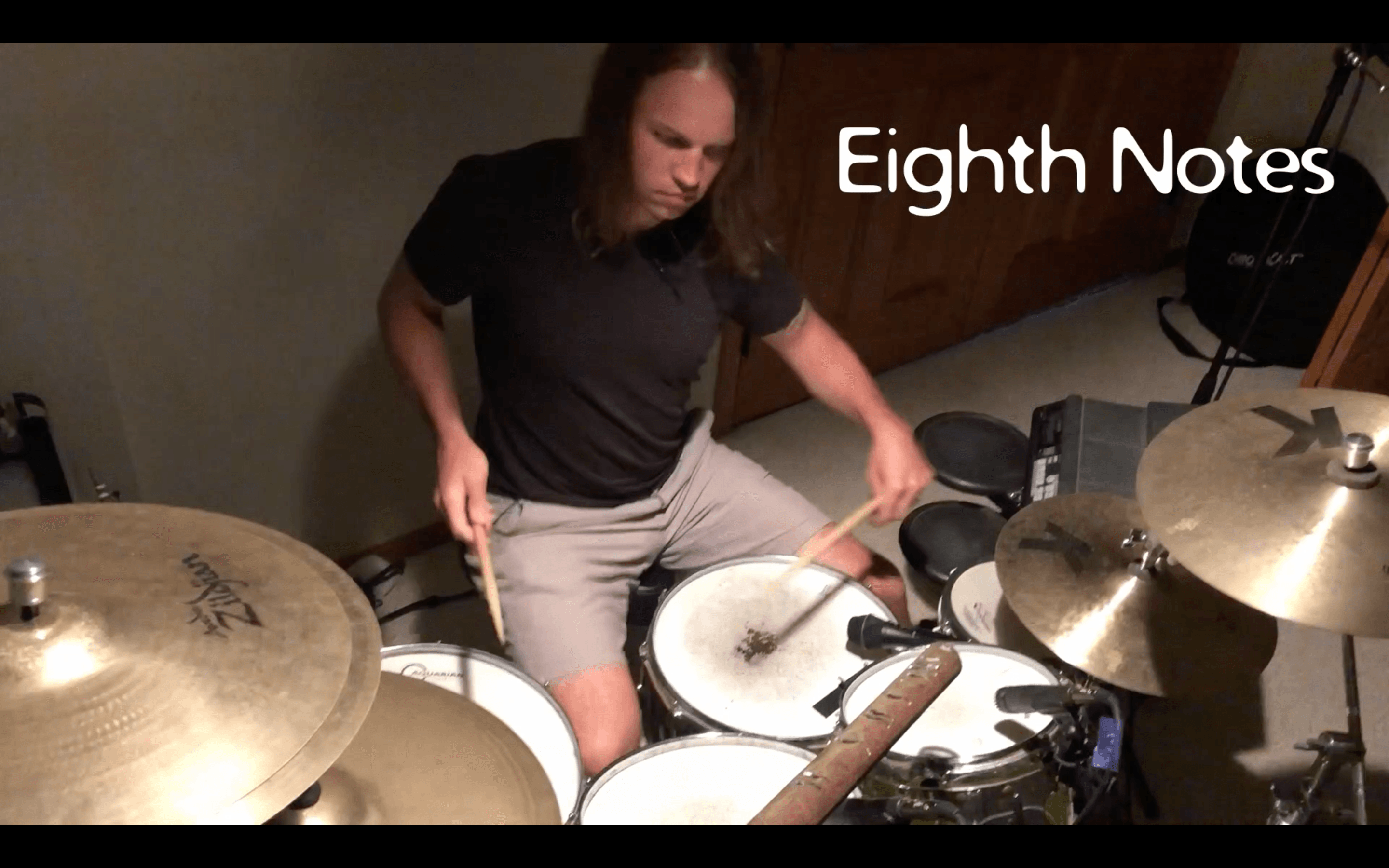
To some, the idea of improvising is elusive as it is difficult. If you feel like you can’t improvise, then you probably just need to try a different approach. When you improvise, you can’t really be “wrong”. There isn’t a correct way to improvise.
Sure, you may want to stay in time or support the band, but you don’t have to. And, you shouldn’t expect to be able to do that right away. The best improvisations are captured when the musicians take risks out of their comfort zone. Sometimes you may want to make the time “elastic” to convey an idea in your head. Sometimes you are taking the forefront of the band for a solo or a transition into a new section or feel.
As long as your ideas are musical, confident, and purposeful, it can enhance the performance.
This exercise can help build confidence in improvising so you can push your comfort zone and create that magic on stage called improvisation. It has literally been one of the best things I have added to my practice regimen for many reasons:
I was originally taught this exercise from my old teacher and longtime friend, Jesse Peterson, around the year 2000 or 2001. He was a former student of Dave King (The Bad Plus, Happy Apple, Dave King Trucking Company). If you are familiar of either of these guys playing, you can hear a masterful approach to phrasing and improvisation in their playing.
I was blown away when I saw that Dave actually referred to this exercise in a recent Drumeo video about improvising. When I saw this, I knew I wanted to share the clear and concise way Jesse taught me. He made it into an exercise with clear rules to improvise within. Concepts are more difficult for some of students to grasp without direct guidelines.
When Jesse showed this to me, he taught it as if it was a daily warmup and I think it can be a very powerful exercise if it’s done regularly. The genius behind Dave and Jesse literally changed my life and my drumming forever—and I’m not kidding. I am grateful that they taught me this exercise and I do not claim it as my own.
Improvised Rhythmic Permutations Exercise
Basically, set your metronome by choosing a tempo anywhere from 60 to 80 bpm or even up to 100 or 120 bpm depending on your skill level. With the metronome, improvise by hitting random sound sources as quarter notes only (directly on the metronome clicks). Do not hit the same sound source more than 2 or 3 times in a row. Be sure to incorporate all of your limbs and accents.
After improvising simple quarter note ideas and phrases, move on to quarter note triplets. After that continue onto eighth notes, eighth note triplets, sixteenth notes, and eventually sixteenth note triplets.
As you improvise hitting random sound sources, you will start to hear rhythmic phrases that you’ll want to react to. Embrace the idea that the phrases are longer than a one bar drum fill and allow them to extend beyond the barline. It is important that you still know where the beats AND downbeats are. This is where you ears will start to learn unique accents and phrasing.
It literally forces you to “think outside the bar lines”
Don’t limit yourself to clean hits on the drums and cymbals. Incorporate hi-hat foot splashes, ruffs and buzzes, cymbal chokes, drum rims, hardware slides, cymbal screeches, etc.
As you get comfortable with this exercise, you can begin to break the rules a bit by adding some rests, hitting 2 or more sound sources at the same time, hitting more than 2 hits on the same sound source. Just remember that it is important to set rules or guidelines to improvise within in order to explore your improv capabilities.
I have provided a video of myself doing this exercise as one of my warm-ups until I couldn’t keep it together anymore. If you don't make any mistakes when you're doing this, you're not taking enough riffs to explore new phrasing and rhythms!
Simplify or Challenge Yourself
At first you may want to keep it simple and remove the triplets. You could just go from quarter notes, to eighth notes and then to sixteenth notes. Eventually, you should add the triplets back in. You could even make it an advanced exercise by adding quintuplets, septuplets, and beyond!
To hear Dave King refer to this exercise, check out the video below and skip ahead to 19:43 or 31:25. He explains his approach to this idea and then plays an example. Make sure you take the time and watch the entire video—literally AMAZING and priceless lesson on improvisation.
Comment below with videos of your own versions of the “Improvised Rhythmic Permutations Exercise”! Thanks for reading!
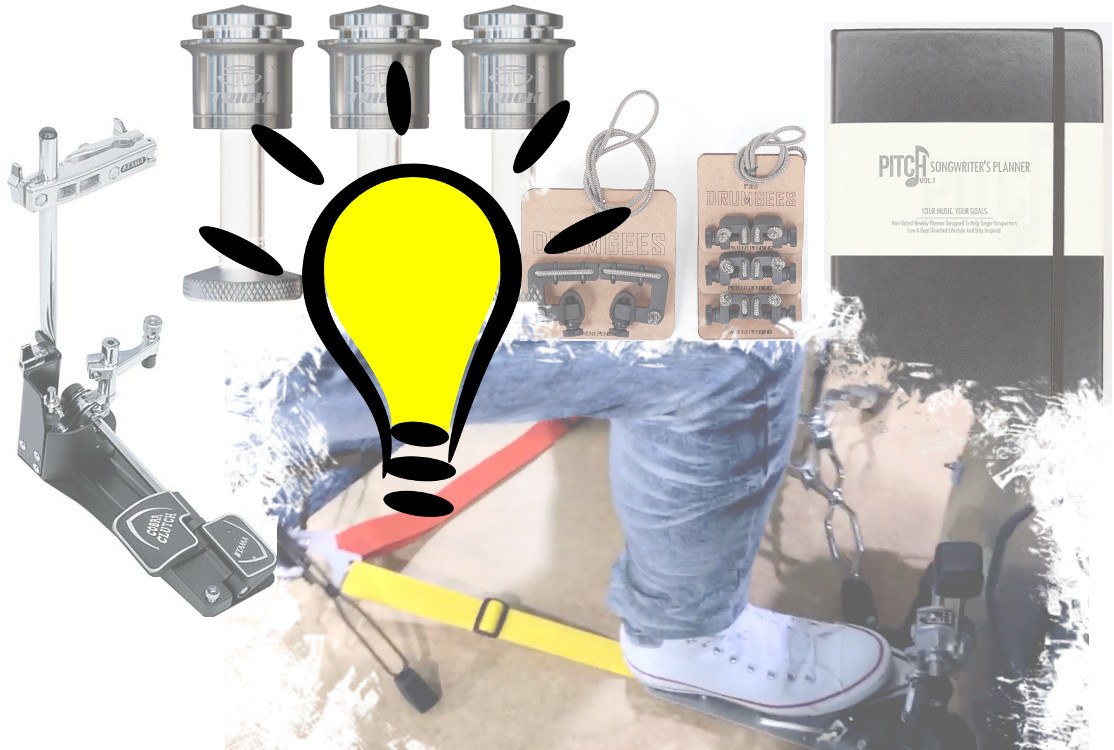
We’ve all seen the “top gifts for drummers” and “essential gear” articles, but I haven’t seen many articles listing the uniquely useful drum gadgets. Some of these you have probably heard about but I’m willing to bet you haven’t heard of all of these. I use almost all of these regularly and I plan to eventually buy all of them. I just couldn’t wait to share all of the cool drum gear that you didn’t know you needed with optional drum hacks!
Tama Cobra Clutch (DISCONTINUED)

TAMA TAMHH905XP Cobra Clutch (view item on Amazon.com) (commissioned links)
The Tama Cobra Clutch is a product that has solved a problem for double bass drummers ever since Louie Bellson brought them to the bandstand. When you move your foot from your hi-hat to your second bass drum pedal, you relinquish the control of the hi-hat foot pedal and how much you want the cymbals open or closed. This clutch allows you to set your hi-hat at any level of openness with the push of a pedal. You can have your hi-hats tightly closed or slightly open for a sloshy sound while you play double bass.
Regular hi-hat clutch users, such as myself, have long desired having an option for the amount of slosh when playing double bass. Most drummers remedy this by setting their hi-hat to slightly open and never touching it. This is at the sacrifice of not having the option for a hi-hat wide open nor a loud 'chick' sound when using the hi-hat with your foot. At a hefty price tag, you can solve these problems with the Tama Cobra Clutch. This pedal sits to the side of your hi-hat pedal to easily set and unset.
Drum Hack
I think their needs to be a more affordable product to achieve the slosh sound when playing double bass. Long before this even came out, I came up with my own drum hack that literally costs around a dollar. Simply buy a strong spring that can fit around your hi-hat shaft. Most hi-hat stands have a 1/4" shaft so you would need a 3/8" spring like this one: 3/8" by 3/4" spring. Cut it to length and place it in between the two cymbals. This will hold the top cymbal up slightly when your regular hi-hat clutch is dis-engaged for a slosh and still allow for your pedal to work when the clutch is engaged.
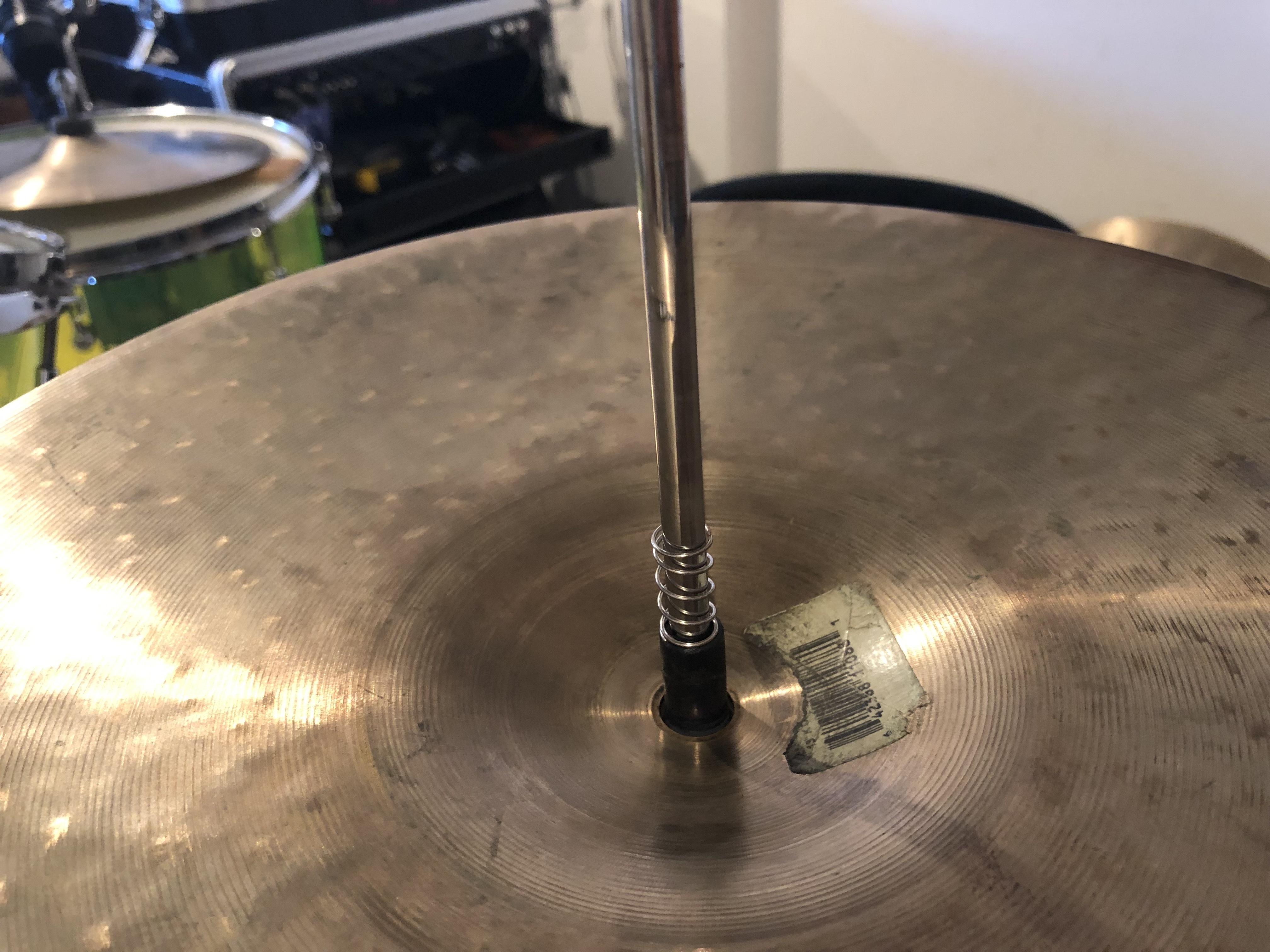
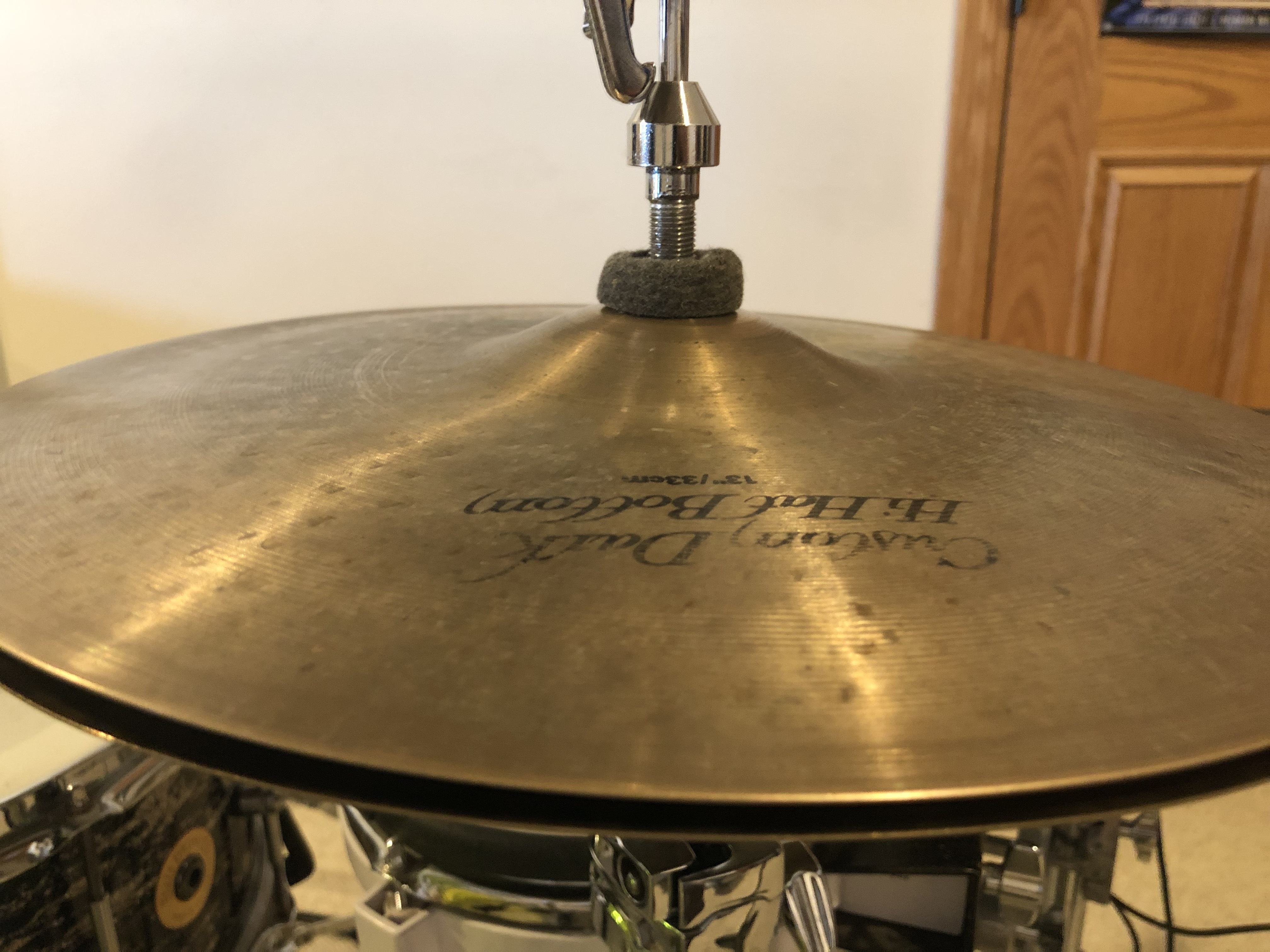
However, this only gives you the option for slosh when playing double bass. Gavin Harrison likes to have the option for slosh or tight as he explains in this official Tama video:
Meinl Cymbal Tuners

Meinl Cymbals MCT Tuners (view item on Amazon.com) (commissioned links)
A lot of people talk about the Meinl tuners in articles like this so you have probably heard of them. There are mixed reviews on these and I think there's a couple things that need to be said about them. First of all, they don't just make you cymbal quieter. They transform your cymbal into a different but more quiet cymbal depending on where you place the magnets. I like the sounds I can get out of these, but it does depend on the cymbal you are using. I would urge your local drum shop to keep a set of these in the cymbal room so you can test them on different cymbals.
So, yes, these do make your cymbals more quiet at the expense of sometimes wanted overtones. If you want quiet cymbals, you really need to learn to play them more quiet with finesse. This is an important skill to work on especially when you're in the studio. If you are playing your cymbals too loud, it will bleed into the other microphones requiring you to gate or use other production techniques. It can also completely take over your overhead mics forcing you to turn down the overheads at the expense of losing bulk and essential overall room sound. Keep that in mind if you buy this product.
Drum Hack
There are some cheaper options to achieve this but they may not work as well as the Meinl tuners. I used to put duct tape on the underside of the cymbal but it left a nasty residue. Then I heard about these super strong neodymium rare earth magnets online for a fraction of the cost. You just need to put some sort of adhesive felt on them so they don't scratch your cymbal. I have not tried this but have heard that they work just as well. Comment below if you have tried this!

Nexlevl Super Strong Mini Fridge Magnets 1/4" x 1/16" (view item on Amazon.com) (commissioned links)
Gibraltar Shock Mount Cymbal Adapter

Gibraltar SC-GMCMA Shock Mount Cymbal Adaptor (view item on Amazon.com) (commissioned links)
I usually have more cymbal stands sitting around rather than mic stands. This is perfect for that. It mounts to most cymbal stands. This product is intended for use on a cymbal stand when you have a cymbal mounted as well, that is why it also has shock absorption. It also absorbs the shock when you mount the stand on a rack.
I have wrapped tape onto cymbal stands so I could mount mic clips on them but this only works for a while until they fall off, damaging your microphone. I was definitely happy to find this product! I see the reviews aren't very good but that's because the rubber piece, which absorbs the shock, breaks...just be careful!
Drumgees
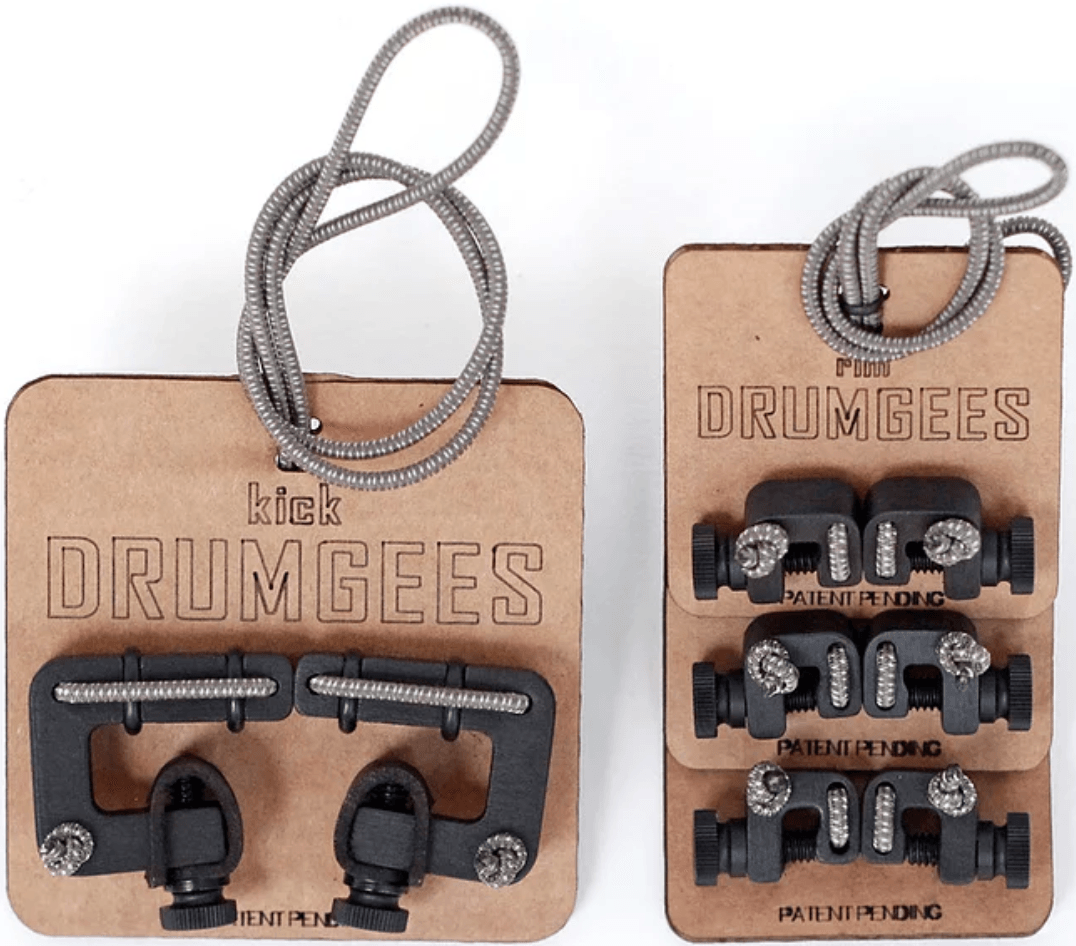
Drumgees (view item on Drumgees homepage) (commissioned links)
This product allows you to "bungee" any sound source to a drum. If you have ever experimented with putting pans, towels, or anything else on your drums, these hold them in place. They also have clips that can quickly and easily secure them into place. This is right up my alley, I just wish they weren't so spendy!
Drum Hack
I hate to suggest this option because I like to support small businesses but there are some decent options that are WAY cheaper. Just buy a mini bungee cord with a plastic hook (to prevent scratching). I found these elastic buckle cords on Amazon and the hook works well with a drum rim. You can untie the bungee and put a second hook on it. They won't work as well as the Drumgees though...especially with their the ease of use when playing live.
Drumlites
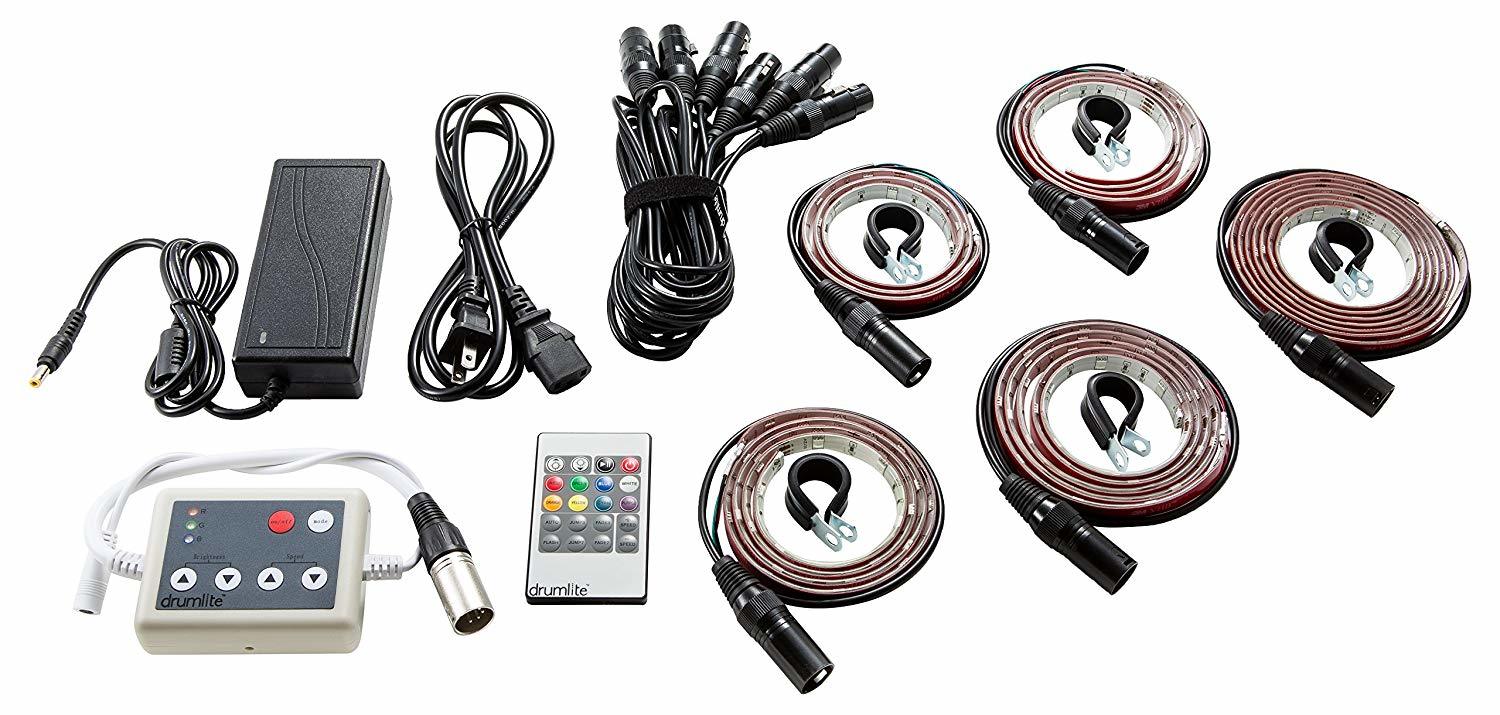
DrumLite Electronic Drum Accessory DL2N (view item on Amazon.com) (commissioned links)
These Drumlites are amazing! I have an acrylic "see-through" drum set but these also work great with wooden kits. The remote control allows you to pick a bunch of different presets and colors. I chose to buy the Global DMX Controller so I could have the lights react to my music. This is definitely the way to go because with DMX control, you can do anything.
I will mention that the Global DMX Controller only allows you to show the same color on all the Drumlites you have (hence the name global). However, the Independent Controller with DMX Function allows you the ultimate control to do anything...at a really hefty price tag!
They also sell Drumlites that are triggered by sound, but they are not interchangeable or upgradable to the DMX controlled lights. I easily found a way to trigger the DMX controlled lights by sound with my setup in Ableton Live. But, in order to use it on each drum separately, I would have to buy the independent controller. That's where the triggered Drumlites are much more affordable. I still chose the Global DMX Controller for now with hopes to eventually upgrade to the independent controller.
My drum transcription video of "Moon" by Little People shows the first time I programmed my Drumlites in sync with the music. Check it out here: Moon by Little People - Drum Transcription by Robin Rapsys
Here are a couple official videos from Drumlite with Coop3rDrumm3r explaining their setup and uses. The second video shows their "triggered" version which cannot be interchangeable with the DMX controller. Like I said, with a little setup, you can easily do this with Ableton and a DMX controller. I will be releasing some videos on how I do this soon.
Trick Drums Cymbal Quick Release
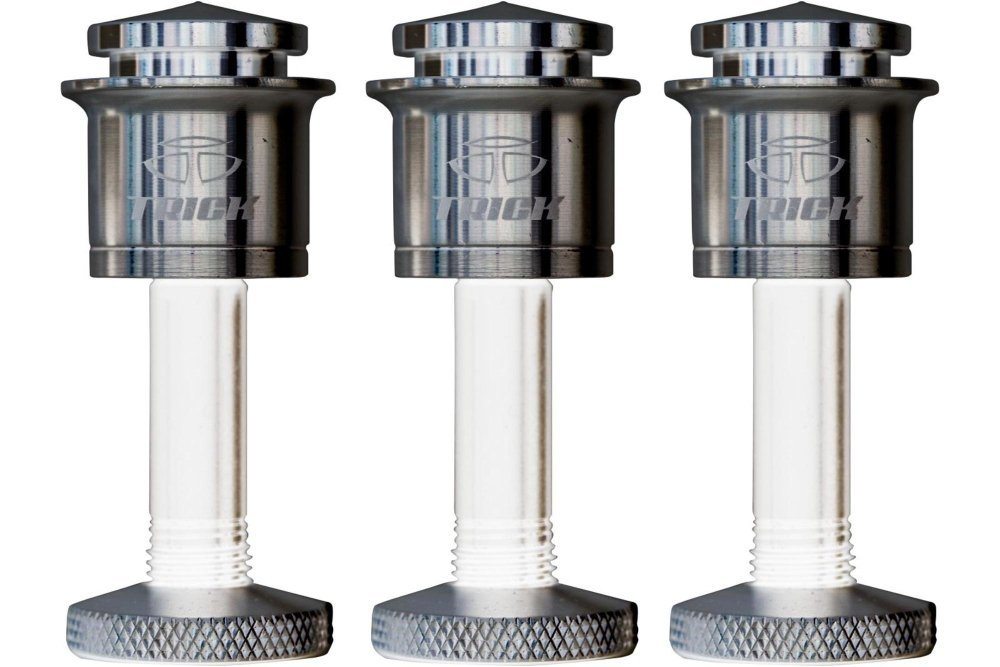
Trick Cymbal Quick Release 3-pack (view item on Amazon.com) (commissioned links)
The Trick Drums Cymbal Quick Release is by far the best of its type. There's a reason they're so expensive! They screw onto almost any cymbal stand, include felt washers, adjust for tightness, and of course...quick release when you pull on the top. And trust me, they do not "accidentally" pop off.
I have to be honest, the Tama Quick-set Cymbal Mates do not work very well; they fall off numerous times on a gig. The Vater Slick Nut works pretty well but you do have to adjust them with an allen wrench every so often and they can also mess up the threads on your stand. I spent $60 on three of the Trick Quick Releases and I am set forever...no more problems! Amazon also offers the Trick Cymbal Quick Release as a 2-pack or a 1-pack.
The KickStrap - Bass Drum Creep Solution
This is the best solution for bass drum creep I have found. It's basically a strap that hooks to your bass drum pedal or hi-hat foot pedal and then to the center pipe of your drum throne. There's another product out there called "KickLock" which is similar to this product. However with KickLock, the strap hooks to one of the throne legs so I would have a concern of accidentally lifting my throne leg while I'm playing and disconnecting the KickLock. It also wouldn't work with raised bass drums because the strap attaches to the lugs of your bass drum causing the strap to sit up off of the ground and trip you up when you move or stand during play.
The people at Kickstrap are very nice and have great customer service. That kind of thing goes a long way and I like to support businesses that care about their customers! When you order, they will help make sure you are getting the correct KickStrap that will fit your pedal. I had a great experience overall with Benson's Music and the KickStrap.
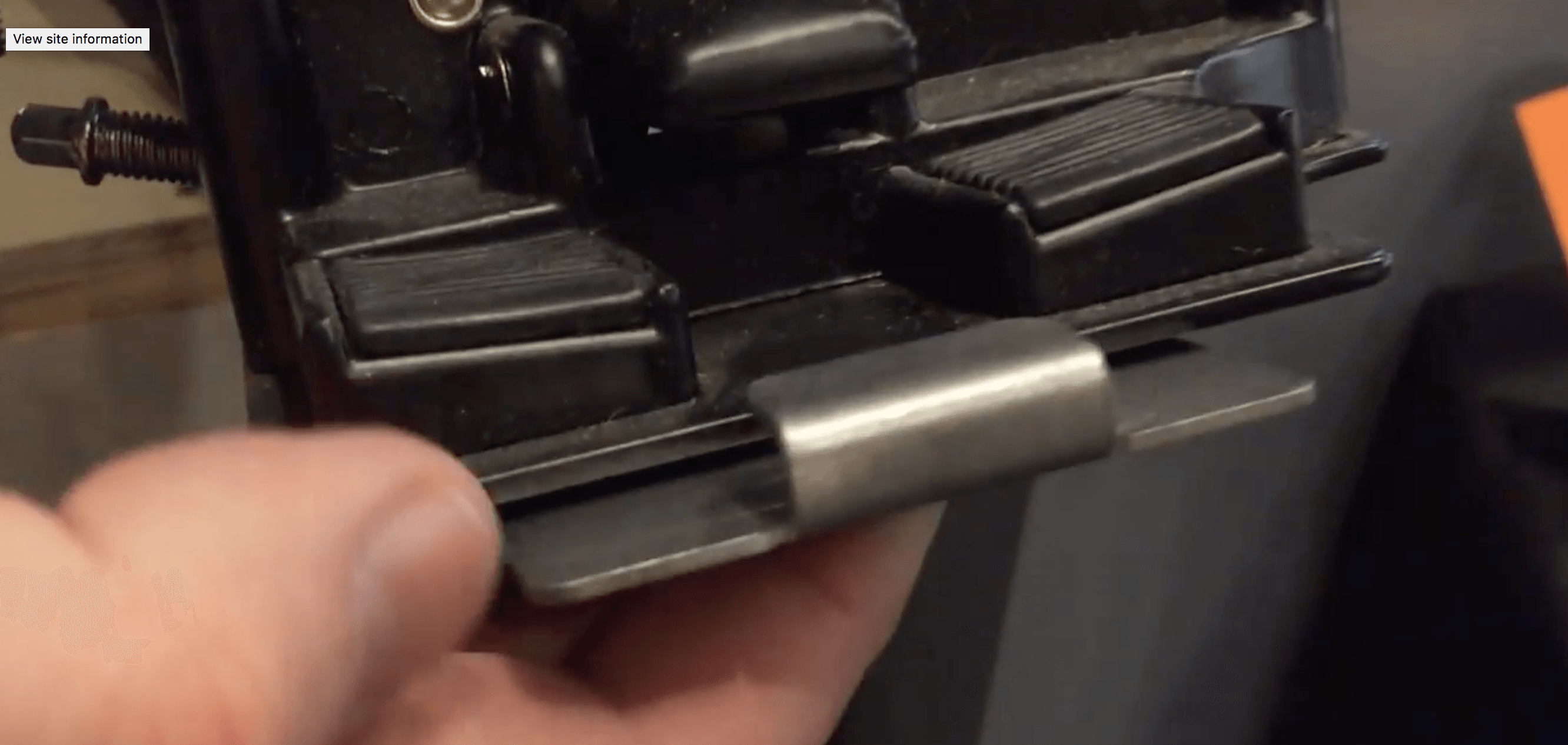

Meinl Cymbal Bacon

Meinl Cymbal Bacon (view item on Amazon.com) (commissioned links)
The Meinl Cymbal Bacon is a pretty well known product to create a sizzle effect on your ride or crash cymbal. I found this one to work the best because it's not so bulky and the built-in washer fits right on top of your felt washer. I didn't like the Pro-Mark Sizzlers because they were too bulky. The built-in felt and plastic piece didn't fit on some cymbal stands too.
Drum Hack
Of course, you can always take a necklace and drape it over you cymbal stand. Sometimes you need a piece of tape or something to secure it to the cymbal stand. I found that the "dog tag" style necklaces create the best sound which is the same material as the Cymbal Bacon. However, most necklaces will cost more than the Cymbal Bacon and require an extra step to secure it. But, if you have an extra necklace lying around, it could be a quick solution.
Zildjian Anti-Vibe Sticks
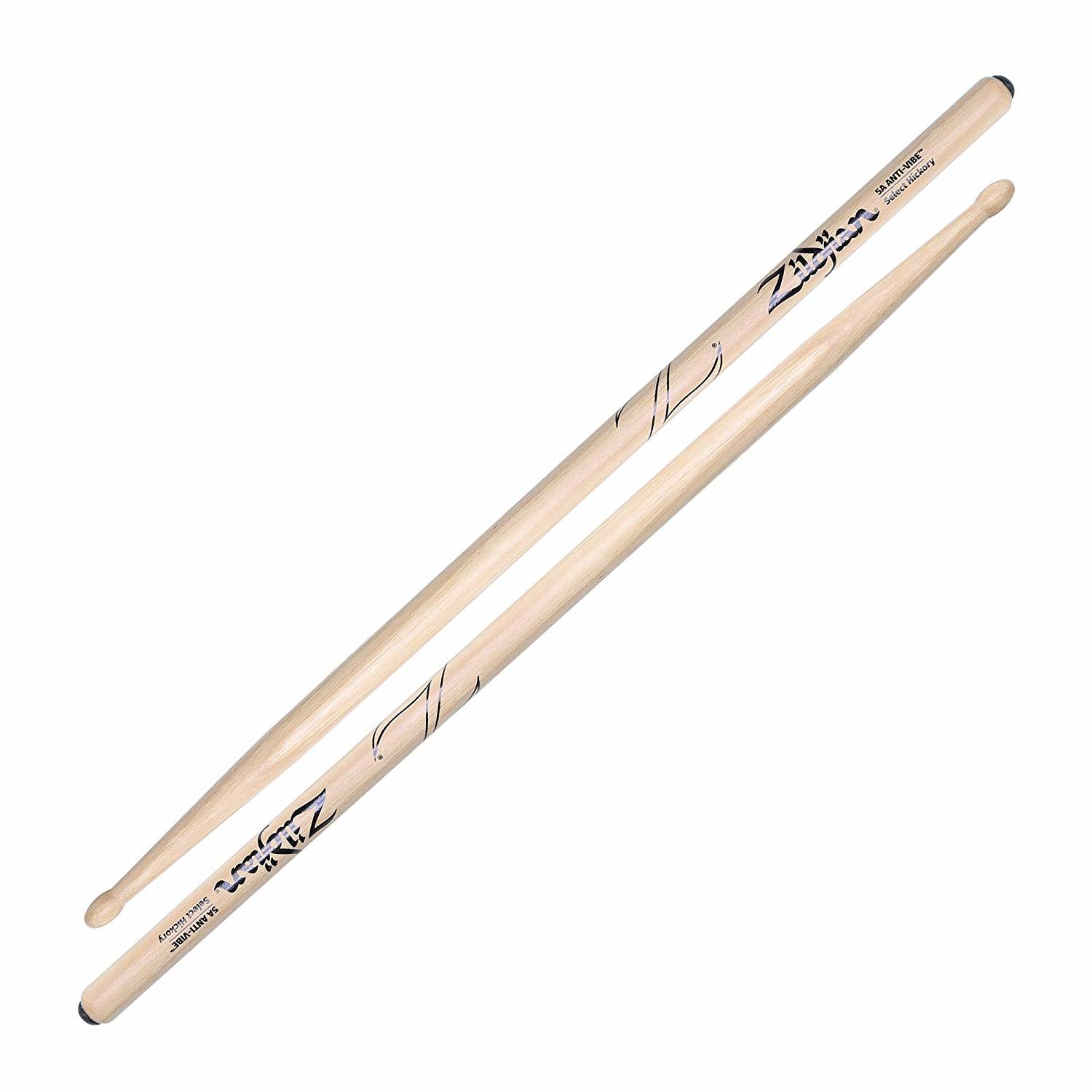
Zildjian 5A Wood Tip Anti-Vibe Sticks (view item on Amazon.com) (commissioned links)
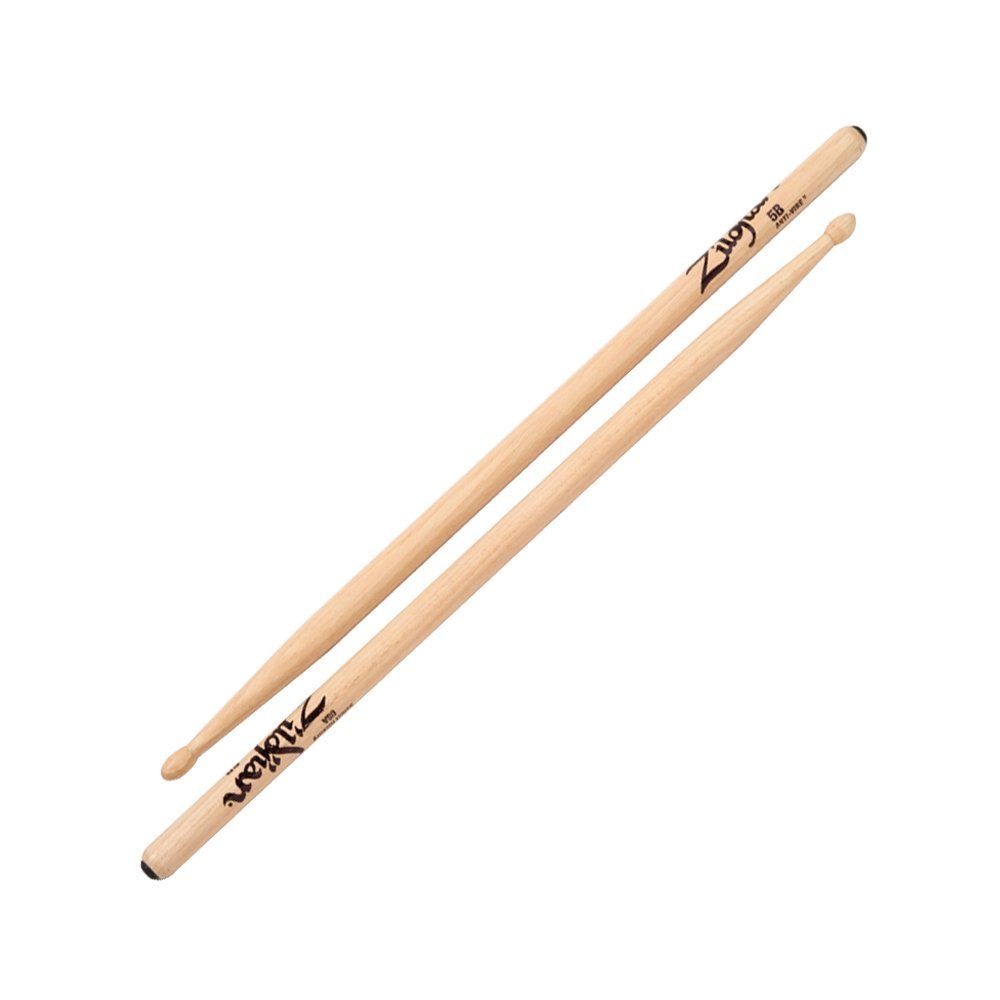
Zildjian 5B Anti-Vibe Sticks - Nylon or Wood Tip, Colored Dips, Birch, Natural, Maple (view item on Amazon.com) (commissioned links)
Have you seen the Zildjian Anti-Vibe Sticks before? They've been around for a while, but they've come a long way. They now offer them with colored dip grips, birch, natural, or maple and nylon or wood tips. There is a little nub on the back end that drastically reduces vibrations from coming down the stick which can cause wear on your wrists, elbows, and shoulders. They feel really nice but the rebound is very different and they take some getting used to. If you have any sort of pain in your hands, wrist, or arms, these sticks can help with that. I think the vibration reducing sticks will become more common in drumming. Anything to prolong the ability to play drums is a good thing!
Pearl Drum Key (Multi-Tool)
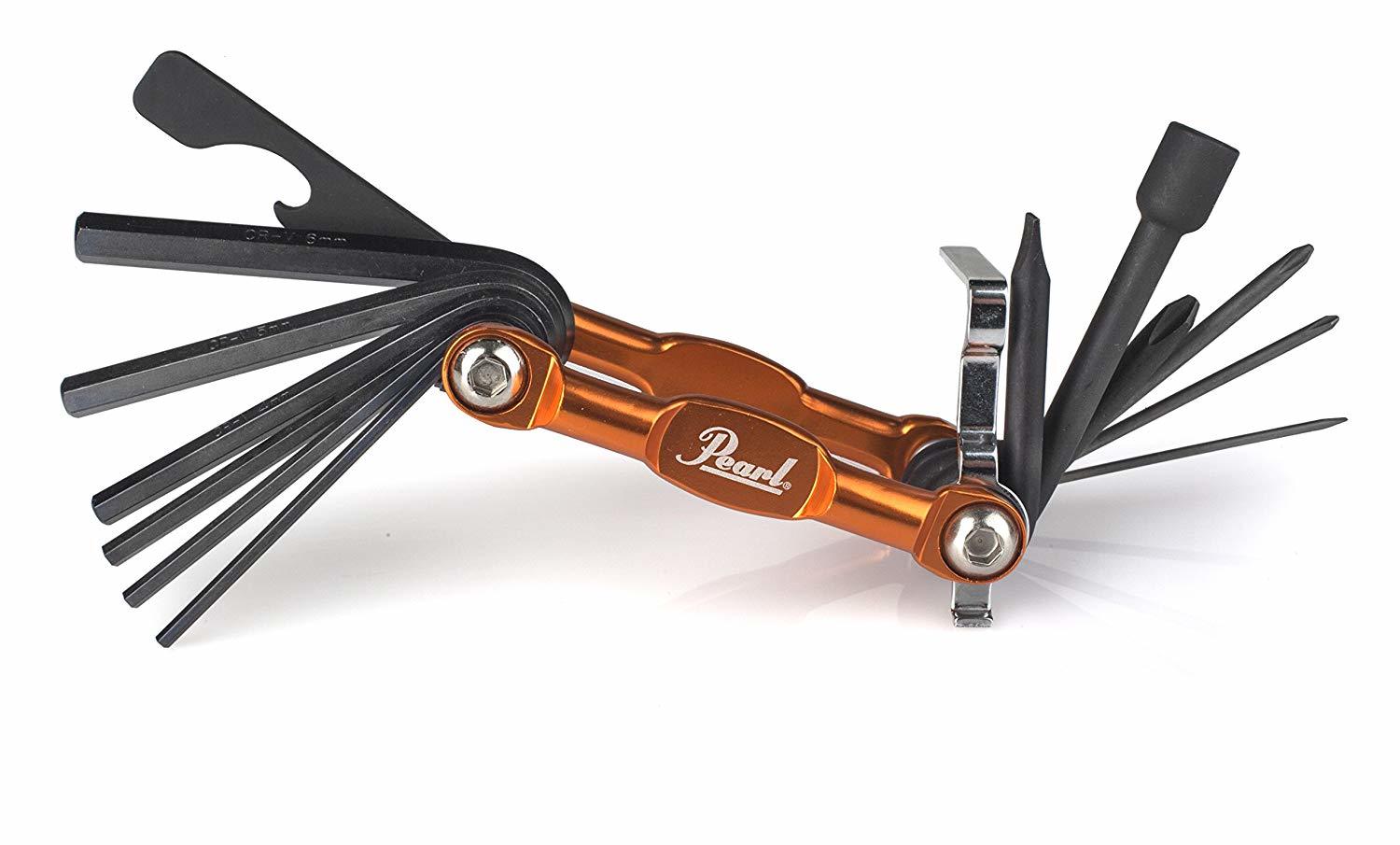
Pearl PTT13 Drum Key (view item on Amazon.com) (commissioned links)
I used to keep a little ziplock bag in my stick bag with allen wrenches, screwdrivers, drum keys, etc. This Pearl Drum Key Multi-Tool alleviates all of that. Vic Firth, Tama, and Zildjian all make a similar version of a multi-tool but Pearl's design is better. It has more allen wrench sizes, more screwdriver sizes, and longer shafts. CruzTOOLs also makes a very similar product that is great, but Pearl 'one-upped' them by adding a bottle opener and a couple more screwdriver sizes. I prefer using this to tune my drums as well because the grip is better than any standard drum key. Definitely the best drum multi-tool on the market.
Tama Tension Locks

Tama Tension Locks (view item on Amazon.com) (commissioned links)
Tama Tension Locks lock your tension rods in place so your drums don't go out of tune while you're playing. There are a bunch of other products out there for this issue but these are the best ones. Why? Well, some of the other products out there wrap around the tension rods underneath the drum hoop which make tuning and changing heads a complete headache. The products that snap onto the top of the rods (Gibraltar Lug Locks, Pearl Tension Keeper, Tuner Fish Lug Locks) are easier but Tama Tension Locks are the only product that allow you to tune the drum while they are installed.
They just push onto the top of your troublesome tension rods and the O-ring allows you to tune the drum while they are on. These are probably one of the more expensive products of this kind but that is because they are the best! You don't need to put these on every rod of every drum either. Only install these on the lugs that seem to fall out of tune due to rim shots.
Evans Torque Key

Evans Torque Key (view item on Amazon.com) (commissioned links)
I am a big proponent of tuning your drums by ear. Recognizing pitches and overtones is an important skill for any musician in general. That is why the Evans Torque Key is the best aid in getting your drums close to "in tune" followed by fine tuning by ear. The DrumDial and Tunebot are so much more expensive of a product when you are only using them to get close.
To use the Torque Key, just turn the bottom dial to a desired tension and turn the key on the tension rod until it clicks. After tuning that same tension on every rod, the drum should be very close to in tune. Record your "tension number" when you find the best tuning for each drum.
I will mention that the Torque key only works well with higher quality drums and tension rods free of rust. Lower quality drums will tend to have inequalities in their tension rods that can lead to uneven torque.
Thank you for reading! I hope the products and/or hacks were helpful in simplifying your drumming life. If you haven't checked out some of my other helpful articles, do so below!
Part 2 of this series:
The Coolest Drum Gadgets you Didn't Know You Wanted - Part 2
Other articles that may interest you:
Everything You Need to Become an Online Session Drummer - Part 1 – Getting Gear
Definitive Drum Practice Guide from Beginner to Advanced - Part 1 - Scheduling and Gear
Definitive Drum Practice Guide from Beginner to Advanced - Part 2 - Practice Session
**Full Disclosure: I earn a commission if you click any of these links and make a purchase, at no additional cost to you.**
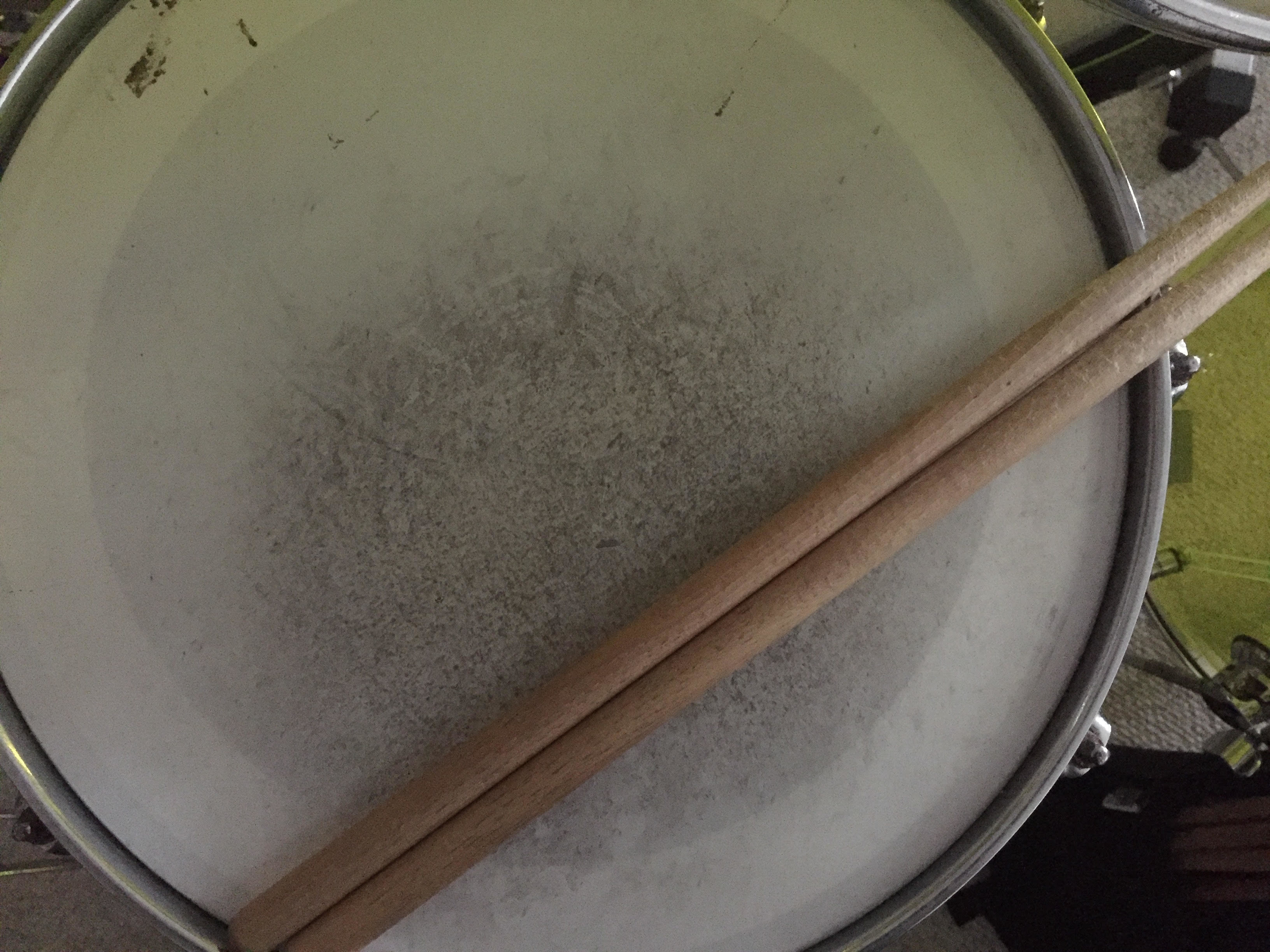
If you didn’t see part 1, go to:
Definitive Drum Practice Guide from Beginner to Advanced - Part 1 - Scheduling and Gear
It covers some very important things like scheduling what you practice and when. We’re about to move onto our actual practice session, but there’s one topic that I need to cover: lessons.
I have an opinion on “lessons vs. self-taught” that I would like to explain so I can help you decide on whether you should get lessons or not. If you are self-taught or would prefer to be a self-taught drummer, then ok, but hear me out.
When you self-teach, in any subject or discipline, it only takes you longer to reach your goals if you do it without the direction of someone that has already reached similar goals. I understand that everyone learns a bit differently, but as long as you have a good teacher, they will always find a solution faster than you can. Otherwise you're just taking shots in the dark to try to figure out techniques, licks, etc.
Bottom line is, good teachers will always help you reach your goals faster. But, if you prefer to take longer in facilitating your drumming skills just so you can have the pride of being self-taught, then I won’t stop you. I understand there could be other reasons, but hopefully it’s not the pride thing. Anyway…
I am sure you already have some sort of setup that you may be particular about. If it’s working, then that’s great. Just remember that the “no pain, no gain” model is not ideal here. You’re essentially doing millions of repeated movements over time and if that movement is causing pain, it will become a problem. I would like to point out that I am not a doctor and you should consult a physician for any definitive answers. I just have some suggestions that could help you on a basic level.
Seat Height
Your current seat height will almost always feel the most comfortable because your accustomed to it right now. However, a physician did tell me that in the seated position, the human body will have the most control of it’s leg movement when the knee is at a 90 degree angle. I would urge you to try this seat height. I chose to “get used” to this seat height and it has worked well for me.
Cymbal Height
When you extend your arm above your head, or your shoulders past a 90 degree angle, you increase the wear on your shoulder. Your arms naturally hang downward as the most relaxed position so you would like to be as close to that as possible. As a suggestion, it’s better to keep your cymbals at eye level when seated or lower.
Stick Grip
I have a simple exercise that has helps me dramatically when it comes to stick grip. Stand up, drop your hands to your sides and completely relax them. Then, freeze one of your hands in that position and bring it up to look at it. Your fingers will naturally be curled a bit. This is your hands most relaxed position. Now, with your other hand, place your drumstick in your frozen hand. After that, you can unfreeze your hand to grip the stick with your thumb and pointer finger as the “fulcrum” while the other three fingers lightly touch the stick. With minimum movement from a fully relaxed position, you should be able to hold onto the stick with the fulcrum and guide the stick with the other three fingers.
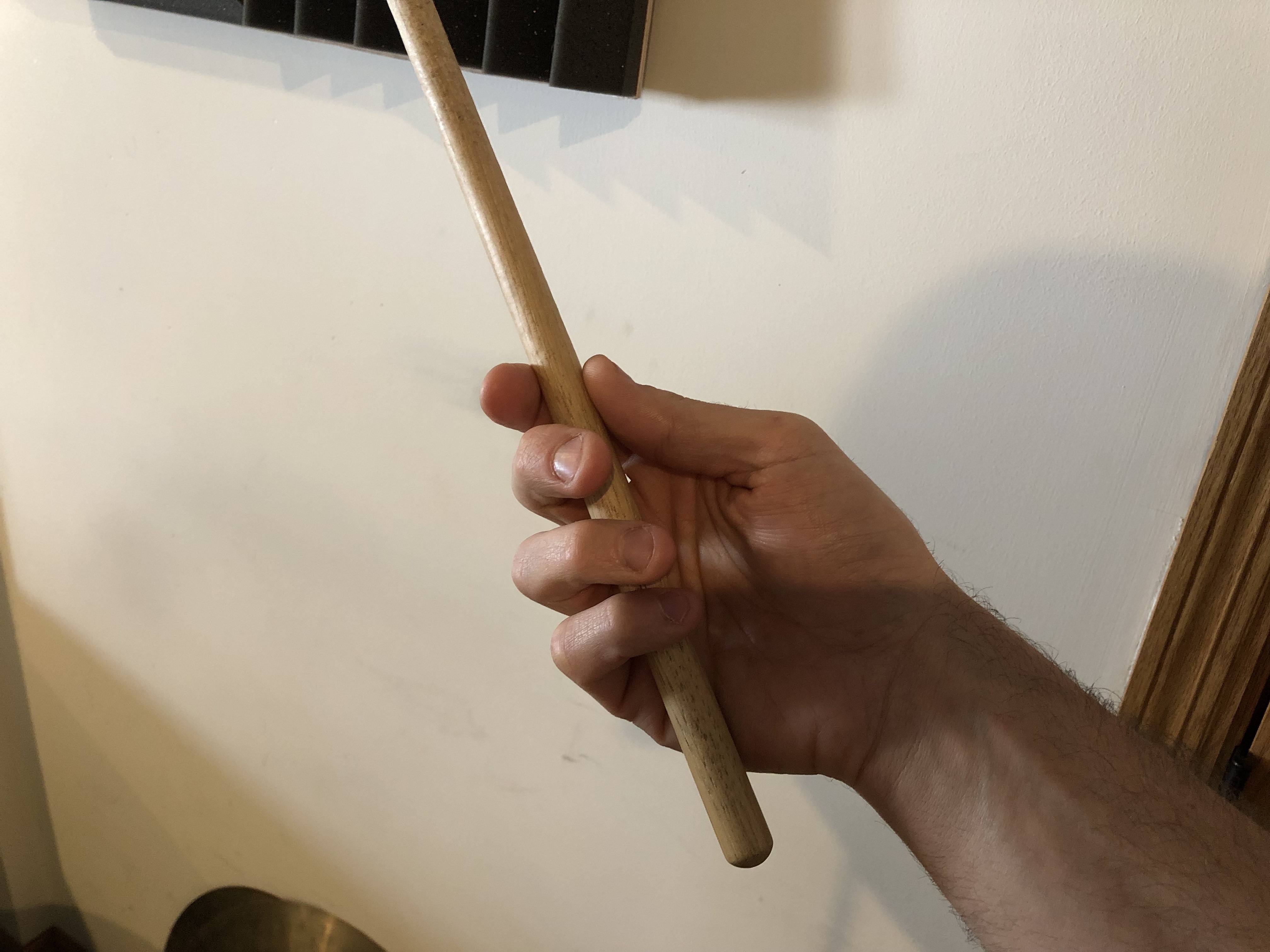
Warm-ups
Warm-ups are essential to a fruitful practice session. To really get the most out of it you should get your body temp up so your not “cold”, then stretch, then play some exercises. All in all, this should not take more than 10 minutes. I know it seems like a long time when you don’t have much, but it is essential. You only have to do it once in a day. If you work out in the morning, you should already be warm and stretched and then you just need to play a few exercises. Just take about 3-5 minutes and stretch these areas out:
Here are some stretches explained if you are unfamiliar with these stretches:
Wrist and Arm Stretches on aaptiv.com
Body Stretches on Self.com
Also, this drummer specific stretch feels great: the stick wrist twist. Just grab your drumstick in the middle and use your other hand to twist the wrist either direction until you feel the stretch and hold for about 10 seconds.
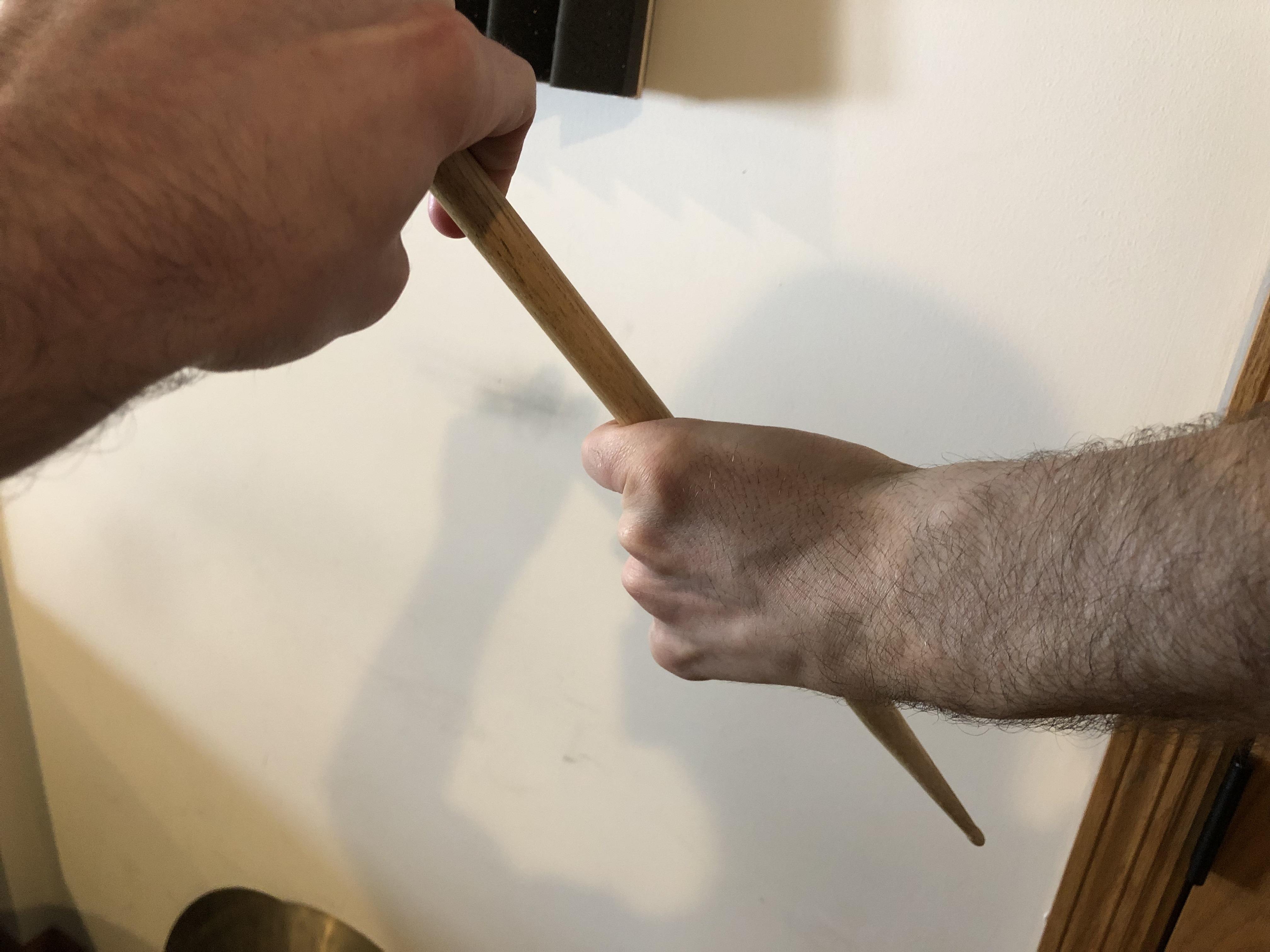
Right hand twisted to the left
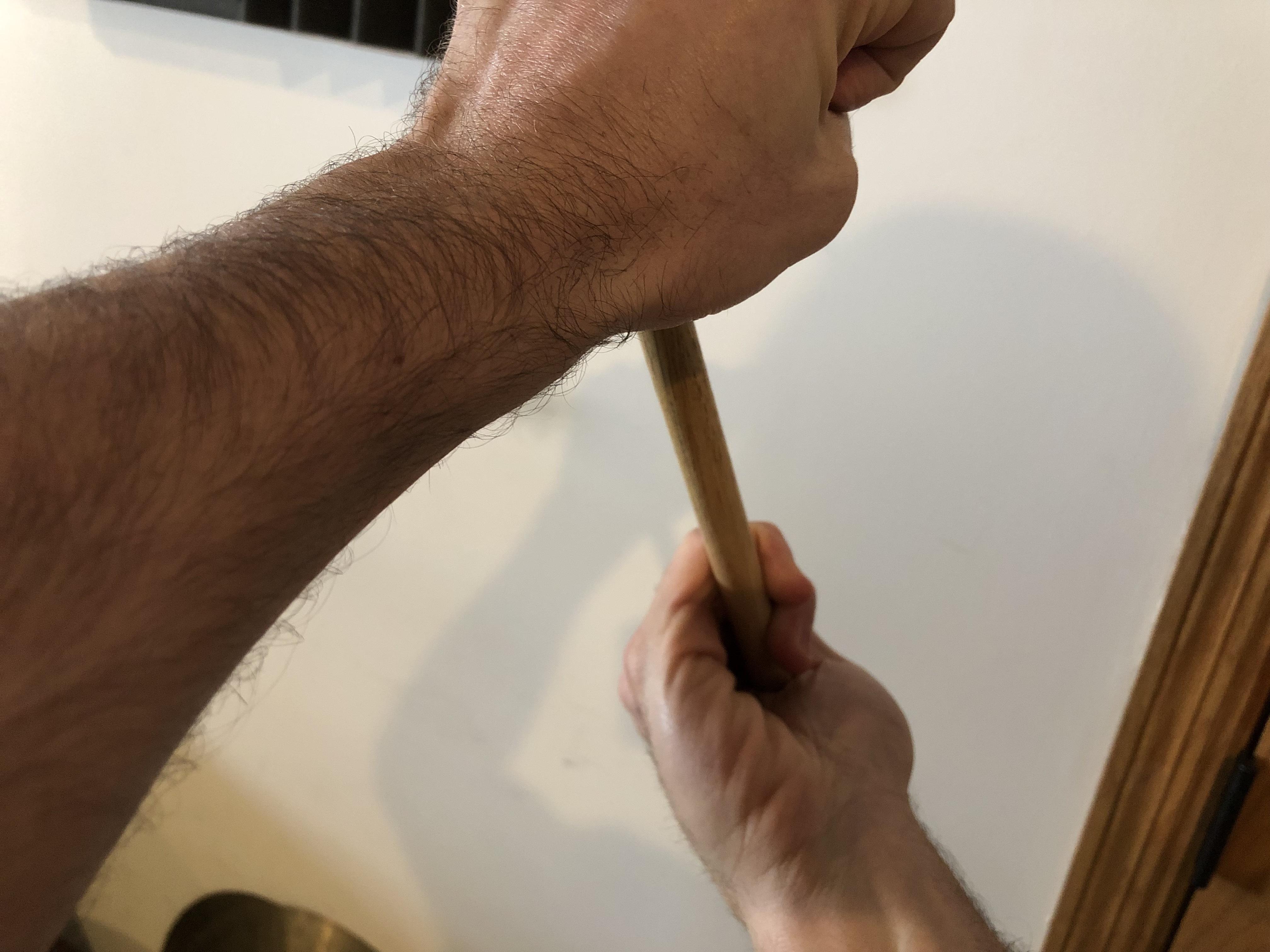
Right hand twisted to the right
Hand Warm-up Routine
I have a hand warm-up routine that warms up my hands AND integrates rudimental practice along with polyrhythms over a metronome click to work on timing. It’s not as complicated as it sounds.
I select two tempos; a slow starter tempo and a fast tempo. I set the metronome so that instead of a click on every beat, it clicks every four beats, or every downbeat. I just divide the tempo I want by 4. So if I want to play this at tempo 60, I have to set my metronome to 15. This might take some time to get good at it so don’t allow it to frustrate you too much! I actually have this setup in an Ableton Project if your metronome doesn’t go this low or if you would like to bring some metronome work to a new level. (look below)
It can be very difficult at first. If you need to, you can start at 80 bpm (which means you would set metronome at 20 bpm). I repeat each segment as many times as necessary and move to each segment without stopping while maintaining the same tempo regardless of the polyrhythmic activity. I have provided a PDF download of my warm-up exercises for you below.
Foot Warm-up Routine
For the feet, I do alternating right-hand/right-foot AND left-hand/left-foot groupings. I play them at a slow tempo and a fast tempo and repeat each segment as necessary just like the hand warm-ups. These really wake up my feet and help me sync my hands and feet better in all of my playing. This exercise is also notated in the warmups PDF below.
Metronome Tools
The last piece of the warm-up I sometimes do I call the “Hold Groove”. I pick any tempo and play a groove for 32 bars using my “Hold Groove” clip in Ableton Live. Basically, the metronome plays fewer and fewer times throughout the 32 bar clip. First it’s on every downbeat, then it’s every two bars, and eventually it doesn’t click for 4 measures. This is a test to see how well you can maintain the tempo. Make sure you try drastically different tempos each day.
In this Ableton project, if you switch over to arrangement view, there is a clip that progressively adds 1 bpm to the tempo every four bars. This works great if you’re trying to work up a new lick or groove. The instructions on how to use all of these features will be in the email I send you.
Practice Session
Finally it’s time to practice! So what do you practice? That question could ask a million more questions. What are your goals? What styles do you like? What are you good at and what do you need to work on? I’m hoping I can help you answer those questions by making some suggestions here.
Books
First of all, it is quite difficult to learn new musical styles or exercises without being able to read music. To play music, it’s not essential, but, it will help you move forward so much faster if you learn to read music. It opens an entire world of interesting books with exercises and concepts that would be difficult to utilize without knowing how to read music. Most beginning method books for any instrument teach how to read music. Here are some of the tried and true, best drum books out there.
Snare Drum
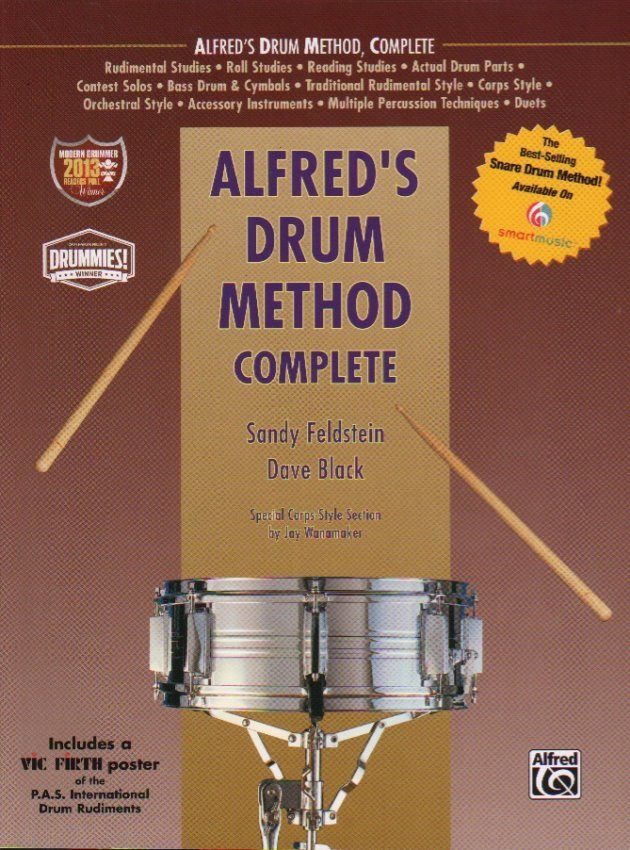
The Alfred series’ are always high quality and this one has been around forever. It has a fantastic method for learning to read rhythms and music and it goes over all the rudiments in a sensical chronology. This one is necessary if you're just starting out. (view item on Amazon.com) (commissioned links)

This book is comprised of snare drum solos that are somewhat advanced. The rhythms can be complex and the dynamics are very challenging. These snare drum solos can help you with drum set dynamics, rhythm, fills, and everything in between. (view item on Amazon.com) (commissioned links)
Rock

Another Alfred book! I literally learned to play drum set from this book. I still use a bunch of excerpts from this book in my lessons I teach today. It starts with the basics and starts to add simple beats and drum fills. There’s even an introduction to jazz in the second half. I would highly suggest getting it with access to the audio examples/CD. (view item on Amazon.com) (commissioned links)

This book was written by the legendary Peter Erskine of Weather Report (Listen on Amazon Music) and countless other groups. It is more of a complete series that starts basic and progresses quickly by the third book. I also think the beats in this series are very applicable in music today. I use a lot of exercises from this book in my lessons. Just start with book one and go from there. (view item on Amazon.com) (commissioned links)
Jazz
Both written by John Riley, an amazing drummer and educator in his own right, these two books are staples for learning jazz drumming. Not only are the exercises interesting and relevant, these books teach the entire concept behind bop music from forms and phrasing to motifs and soloing. (Art of Bop Drumming on Amazon.com / Beyond Bop Drumming on Amazon.com) (commissioned links)
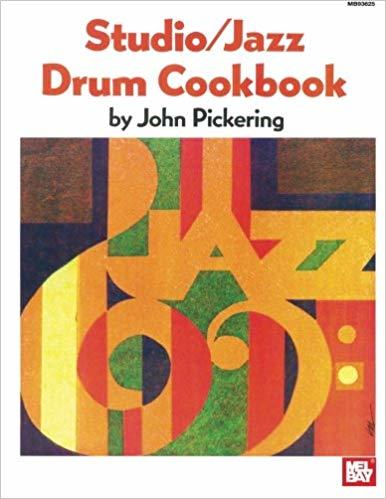
I like this book because it just has a ton of usable swing exercises to go over which can give you new rhythmic ideas for comping. (view item on Amazon.com) (commissioned links)
World Music

This book integrates authentic musical styles from Brazil, such as the samba, and combines their numerous percussion parts into ambidextrous, challenging, drum set grooves. I absolutely love the grooves in this book. (view item on Amazon.com) (commissioned links)

Another book from the same series as “Brazilian Rhythms…” that covers the challenging music of West Africa and applies it to the drum set. (view item on Amazon.com) (commissioned links)
Drum 'n' Bass/Electronic

Extremely thorough book with tons of content and exercises written by the great live drum ’n’ bass drummer Johnny Rabb. It walks you through how to come up with improvised drum ’n’ bass beats that sound interesting and authentic. (view item on Amazon.com) (commissioned links)
All Styles

I found this book very thorough and accurate judging by the amount of research the authors did to compile it. This book is a compilation of almost 500 different drum set styles along with a brief history of each and listening suggestions. This isn’t a book you work through from beginning to end. You use it as an encyclopedia when you encounter a new style that you want to learn how to play. (view item on Amazon.com) (commissioned links)
Concepts
Stick Control, written by George Stone, is a very old book of relatively simplistic patterns in sticking and rhythm for which it was used to teach snare drum for marching music. Since its inception, people have taken Stick Control to a whole new level and reconfigured the use of the patterns in very unique ways. It has become one of the most important drum set practice books ever written. Many years later, Joe Morello (of notoriety from Dave Brubeck's classic "Take Five"(Listen on Amazon Music)) a student of Stone, wrote the book Master Studies which takes the patterns and a slew of new ones in Stick Control and explains the different ways you can use them. “Master Studies” is the perfect title for this book. (Stick Control on Amazon.com / Master Studies on Amazon.com) (commissioned links)
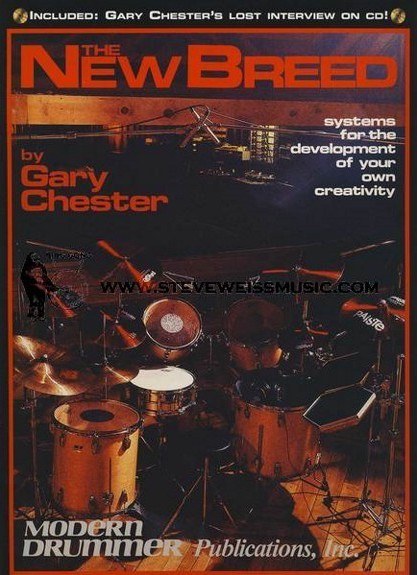
A very interesting conceptual book that integrates a series of systems into your playing to ultimately help you develop your own creativity. I especially like the addition of your “fifth limb”, your voice, which synchronizes your breathing and entire body with the rhythms at hand. (view item on Amazon.com) (commissioned links)
I will also implore you to check out the comprehensive list of timeless drum books from Modern Drummer:
Timeless Drum Books from Modern Drummer
Now, here are some practice tips to keep your eyes on the prize.
How do I work on my "groove" ?
The great Jon Fishman of Phish once used a great analogy to describe time and groove. Just picture a road where the yellow line represents perfect time and the outer white lines to the left and right represent playing on top of the groove and behind the groove. The road's center is usually defined by the rhythm section in the band and where they are implying the song's time exists.
It usually goes unspoken about where each musician chooses to lie on this road. Sometimes the bass player will sit on the back while the drummer pushes the time a bit. Sometimes it's the opposite. The years you spent listening to the music you love by master musicians has given your playing a natural feel that probably sits on its own unique position.
At your next rehearsal, try to start a conversation about where everyone likes to sit in each song. Sometimes when you talk about it, it can solidify the groove. But it can be a confusing concept to some so don't push the idea too hard.
If you are playing slow funk, soul, or any music that asks for a relaxed feel, you would want to consistently play a little bit behind the groove. You should also make sure you relax your shoulders and body when you play. At first, you may feel like your falling behind but as long as you consistently hit your beats a little bit behind, it will have a naturally relaxed feel or sometimes heavy feel.
If you want to give the song some energy, you can sit on top of the beat. This sounds like your speeding up but if you consistently playing a little bit ahead of the beat, you will give the song a front-edge sort of energy. Most rock and metal drummers play like this naturally. If you're not aware of this, it can limit your ability to offer different feels for other songs that might require a relaxed feel like ballads or slow heavy tunes.
Some great examples of drummers playing laidback feels that sound great are ?uestlove of The Roots on the album "Things Fall Apart" (listen on Amazon music), Jeff Porcaro of Toto on the album Toto IV (listen on Amazon music), Chad Smith of the Red Hot Chili Peppers on the album "One Hot Minute" (listen on Amazon music).
Some great examples of drummers playing a front-edge energetic feel are Stewart Copleland of The Police on the album "Regatta de Blanc" (listen on Amazon music), Nicko McBrain of Iron Maiden on the album "Piece of Mind" (listen on Amazon music). (commissioned links)
These are just a few but there are countless other examples you can explore. Here's an article from DRUM! magazine that lists some of the best groove drummers of all time: 15 Greatest Groove Drummers of All Time
This article from DRUM! magazine covers the idea of groove and what kind of feel fits with different styles/genres. Check it out here: Vital Beats Every Drummer Must Know
To work on your groove without a band, you can experiment with a metronome. Try taking different grooves that you are working on and consciously play them on top of the beat, then behind the beat, and then right in the middle of the beat. The more you practice different grooves and styles this way, the easier it will be to hear the differences and apply them to music.
Is it a physical limitation or a coordination issue?
Depending on how long you have been playing and how developed your muscles are, you could find yourself with some physical limitations. These are limitations that require muscle building over time in order to execute. One of the best examples of a physical limitation would be speed.
Hand or foot speed is not something you can work out in a day…it takes time. So, you have to differentiate the elements of what you’re working on so you don’t get frustrated. If there’s an element of speed as part of the groove or style you are working on, allow yourself the time to build the muscles. You could set a time aside during your practice session to work you hand or foot muscles until they burn! If you stay consistent, you will eventually build up that speed.
If you are finding a coordination issue in what your working on, it usually takes a lot less time to work it out. If you slow down the exercise and repeat it over and over slowly, the coordination with come around. You can also work on coordination with mental practice and visualization which I will cover in the next section!
“Amateurs practice until they get it right. Professionals practice until they can’t get it wrong.” -Unknown
Mental Practice
Sometimes we don’t have the time to practice…or, maybe we have idle time when we are away from our drum set. How about when your riding the bus home from work? …when your on an airplane? …when your working out? These are all times that you could visualize practicing and receive the benefit of practicing. Visualizing your practice helps you almost as much as actually practicing!
Here’s a great article from the reputable “Scientific American” which explains that this actually does work:
Can Visualizing Your Body Doing Something Help You Learn to do it Better?
As I said, visualization is a great way to work on coordination. While your riding the bus, plane, treadmill, etc., think of the groove you were last working on and visualize yourself completing the necessary movements to kill that groove.
You can also use mental practice for memorization. Repeating patterns over in your head will engrain them into psyche so you can improvise with them comfortably—especially odd meters! Also try repeating that complex song form in your head so you stop going to the bridge at the wrong time at band practice!
Ari Hoenig wrote a fantastic series of articles for Modern Drummer with the idea of mental practice called “Polyrhythmic Coordination”. He talks about one way to practice mentally is to teach yourself rhythms you couldn’t hear before. The articles he wrote appear in the July 2012, September 2012, November 2012, and February 2013 issues of Modern Drummer. Unfortunately, there’s only the fourth part available online unless you have a digital subscription to Modern Drummer. Here’s a link to Part 4:
Modern Drummer: "Polyrhythmic Coordination" - Part 4 - Six Note Base Rhythm
I hope you enjoyed this article and got something out of it. Be sure to check out some of the other articles I have on my page and keep up the good work.
Be well!
Other articles that may interest you:
Definitive Drum Practice Guide from Beginner to Advanced - Part 1 - Scheduling and Gear
Everything You Need to Become an Online Session Drummer - Part 1 - Getting Gear
**Full Disclosure: I earn a commission if you click any of these links and make a purchase, at no additional cost to you.**

“Every positive change in your life begins with a clear, unequivocal decision that you are going to either do something or stop doing something.” - Anonymous
Practicing a skill in any medium takes a lot of dedication, love, and discipline. Every sports player, musician, or professional in any field, spent countless hours working on their craft. The idea of being born with talent is simply a myth.
If you ask any one of these individuals if their “talent” came naturally, they would give you one of two answers. They would either tell you that their level of mastery came with extensive practice and sacrifices, or they would tell you it came easily. The individual providing the latter answer would simply not remember the time they put in to their craft because they loved it so much and they have no recollection of the “grueling” work they put in.
What I am getting at is if you want to get good at drums, you have to put in the time. Just like in anything else, experience is key. You need to practice and play with musicians as much as you can. When you are amazed by a drummer’s playing, you are actually amazed from the time and effort they put into it. “Wow, that would take a lot of practice to be that good!” It sounds silly but it’s true.
If you already have the basic gear necessities to play and practice, you can skip to the “Scheduling” Section.
If you literally have nothing to play drums on, then I'm going to help you figure out what you need. Some items will seem obvious yet others will not. I am going to share with you everything you need to start playing drums.
Every drummer needs drumsticks, but what kind? There are literally hundreds of different types of drumsticks. So, if you are playing drum set, a good size to buy is 5A in any brand. This size is pretty standard for drum set. They are the “just right” size—not too heavy, not too light. If they seem a little heavy or too loud, you could go with 7As. 7A is the standard jazz drumstick size.

Vic Firth 5A (view item on Amazon.com) (commissioned links)

Vic Firth 7A (view item on Amazon.com) (commissioned links)
If you are joined school band or a community band, then size 2B is what you'll need. They are a bit bigger but they work better for concert snare drum and tom work.

Vic Firth 2B (view item on Amazon.com) (commissioned links)
The next thing you need is something to hit with those sticks. Obviously there are drum sets of all sizes and colors. But you don’t need to start out by spending $800 on a drum set. You could start out with a snare drum or a practice pad. This would get you started practicing techniques like single stroke or double stroke rolls. Even learning to hit a drum properly can be tricky at first.
If you are ready to buy a drum set, I have a great cost effective choice linked right here. Ludwig is a brand that has been around for over 100 years and they have always made great products. One other thing is that not all drum sets come with cymbals, stands, drum throne, or sticks. This one does! I’ll admit the quality of these cymbals aren’t very good but they will work great to start out. Good cymbals can cost anywhere from $200 to $500 a piece so that is an expense you can wait on! However, the drums are great quality Ludwig drums.

Ludwig LC175 Accent Drive Complete Drum Kit (5-Piece) (view item on Amazon.com) (commissioned links)
If you want to start now but don’t have the money for a drum set, get a snare drum. This snare drum I have listed here is also a Ludwig so the quality is there. Snare drums are ideal if you are going to play in school band or a community orchestra or band. If you do buy a snare drum, you will need a stand to go with it. I have an affordable option shown here:
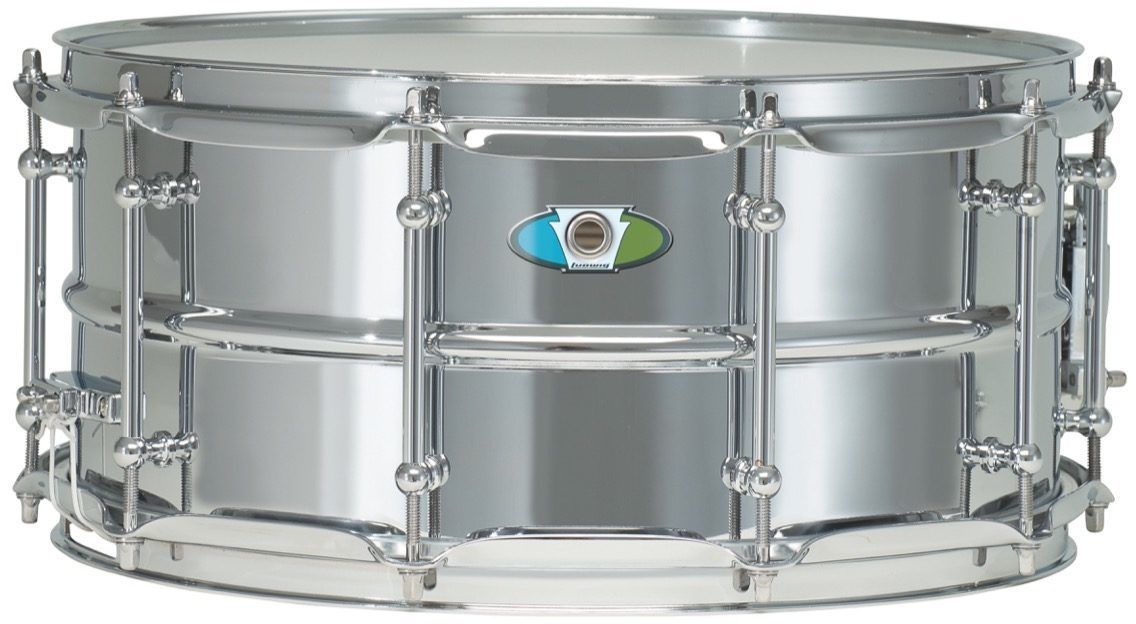
Ludwig Supralite Steel Snare Drum, 6.5x14" (view item on Amazon.com) (commissioned links)
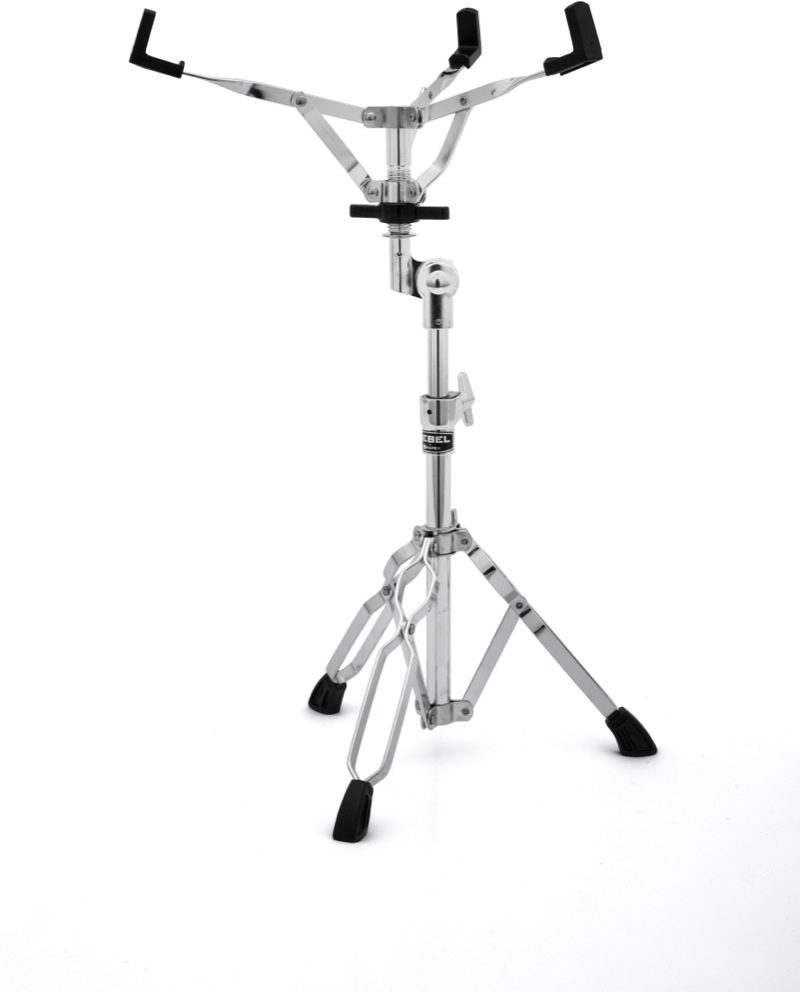
Mapex S200RB Rebel Snare Stand (view item on Amazon.com) (commissioned links)
For around $20, you can get a practice pad and work on almost all the drumming techniques you will need in order to sound good on a drum set. And you will always need a practice pad. I have three myself and I use them all the time. You can use them for warm-ups backstage before shows, late night practice when you can’t be loud, practicing on a beach, or on the john! They’re smaller and easier to transport than a drum set!

Vic Firth 6" Single Sided Practice Pad (view item on Amazon.com) (commissioned links)
When a student joins the school band, a lot of schools require that you purchase a percussion kit. This is a kit that includes sticks, practice pad, bell kit, mallets, and a multi purpose stand. I would highly suggest getting a good quality one for two reasons. First, the cheap ones are really bad and will fall apart before school years end. Secondly, the resale value on a brand name kit will not go down by much. It will sell without trouble because people are always looking for these.

Pearl PK910C Educational Bell Kit (view item on Amazon.com) (commissioned links)
One item that musicians overlook is a metronome. This is an essential practice tool for any musician. A metronome is a small electronic device or a phone app that makes a “click” noise at a perfectly constant speed that you set it to. The clicks are measured by “beats per minute” or BPM. For the math junkies, a metronome set at 60 BPM will click 60 times in one minute.
Almost all music is set to a constant pulse and it is essential for all musicians to have a solid internal pulse that doesn’t speed up or slow down (unless intentional). The only way to practice your internal pulse is to practice along to a metronome set to a perfectly constant tempo.
As a drummer, it is a bit more difficult to practice with a metronome because our instrument is naturally loud. And, as a beginner, it is difficult to control the volume at which we play. So, a lot of metronomes are too quiet to hear while we practice with them. The solution is to get some sort of an in-ear monitor or headphones. This helps block the outside sound allowing us to hear the click.
There are many metronome apps available on our phones that are free. If you go that route you could get these sound isolation headphones: Shure SE215-CL Sound Isolating Earphones. Or, you could use other headphones you already own for the time being but they might not provide very much isolation. Otherwise, you can purchase this ‘all-in-one’ in ear metronome: Korg In-Ear Metronome.

Shure SE215-CL Sound Isolating Earphones (view item on Amazon.com) (commissioned links)

Korg IE1M In-Ear Metronome (view item on Amazon.com) (commissioned links)
So here’s where we’re at for items needed to start playing drums:
Let’s get on to scheduling.
So how do you find time to practice?
Believe it or not, many players do not know how to practice.
The magic is in “learning how to practice”. You need to be aware of how to practice, how much to practice, and what methods to use to reach your goals.
Sometimes players have the speed or facility, but they don’t know what they are listening for with aspects of groove or feel. Sometimes players have good time and feel, but don’t know the techniques to push their chops.
When practicing drums, there are the two aspects of time management:
You need to schedule out your weekly practice time, and you need to schedule out what you work on during your practice time.
You can get so much more done in a week if you do this.
With weekly practice, you have to spread out your time. Your brain needs time to digest what it has learned.
If you practice 15 minutes every day for 5 days, it’s better than one 2 hour practice session in 5 days.
Have you ever worked on a lick or beat to death and you just couldn’t seem to get it down? So then, you quit practicing for the day because you are frustrated. Then, the next day you come back to it and nail it on the first try? That’s because your brain muscle memory need time to process what you have learned to be able to repeat it the way your ears want to hear.
I have made a flexible 12-hour, weekly practice schedule for you. I am telling you that I need this to stay sane! I have ADHD so I need to have tasks scheduled out or I meander through the day and get nothing done! Sound like you?
Use this schedule to plan out your week so you know when you should be practicing! You can enter the time that you normally start your day and continue for 12 hours in 30 minute increments. If there is a extended period of the same activity (ex. WORK), just put a dark squiggle line below that time period and start with a later hour of the day below that.
Fill in these slots with your normal weekly schedule like WORK, GYM, CLASS, LUNCH, WALK DOG, and PRACTICE. You can print a new one out every week if your schedule changes a lot, or just print one out every season. This schedule will help you out with life in general, not just drum practice…but drumming is life right?
I would urge you to start the schedule in the morning even if you work early. If you got 5 minutes on the practice pad with your coffee, you would be doing yourself a great service!
Once you have your weekly schedule figured out, now you need to plan what you do during your practice time.
I created a practice schedule and practice time log to help you here. I use this practice schedule with all of my students. It gives clear start and end dates of your lesson week, the materials to work on for the week, and a log of practice time. I even use this for myself every single week!
The practice materials list keeps me focused on my goals so I don’t get distracted, and the practice log holds you accountable for the actual amount you practiced all week.
This is a visual reminder and it helps tremendously. Remember, you have to spread out your practice time—no playing catch up on Saturday! If you did, you will see that from the previous week.
Now you are all scheduled out and organized to start practicing! Trust me when I say, "this is half the battle!" It's just like when they say, getting to the gym is half the battle. This just might even change your life...it changed mine!
I had to make this a two part series because I still have a lot to go over!
Thanks for reading!
Here is a link to Part 2:
Definitive Drum Practice Guide from Beginner to Advanced – Part 2 – Practice Session
Other articles that may interest you:
Everything You Need to Become an Online Session Drummer - Part 1 - Getting Gear
**Full Disclosure: I earn a commission if you click any of these links and make a purchase, at no additional cost to you.**
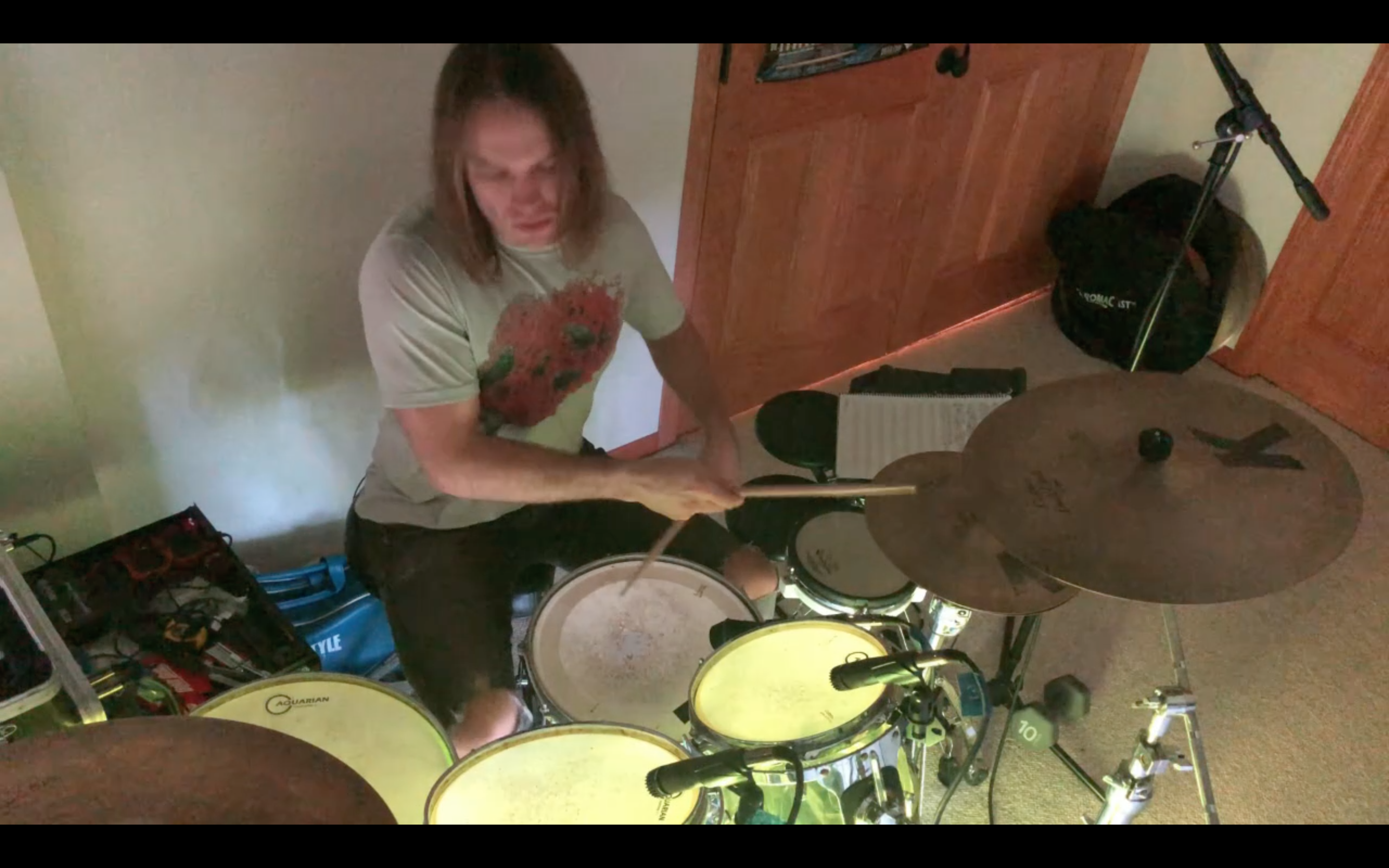
The album "Mickey Mouse Operation" by Little People (Listen on Amazon Music) is one of my favorites from the 2000s in the instrumental hip-hop genre. All the tunes are simple and really cool. This is a short transcription of the beat repeat section from the track "Moon", similar to the DJ Shadow Drum Transcription I did. The snippet I play here runs from 1:22 to 2:25. I also synced my new Drumlites to the track. (commissioned links)
There are a few quick 'linear flourishes' in here. Linear drumming is when only one sound source is being hit at a time--or when no two sound sources are hit simultaneously. The hits are usually in pretty quick succession too. A lot of times when drummers use linear drumming patterns in a song, they are not usually completely linear but only "linear-esque". I think the drummers usually make a conscious decision to do this so that the parts don't sound "too linear", and consequently, without variety or space to breathe.
A couple of examples of linear drumming I really like are "50 Ways to Leave Your Lover" by Paul Simon (Listen on Amazon Music) with drummer Steve Gadd and "Digital Bath" by the Deftones (Listen on Amazon Music) with drummer Abe Cunningham. Here is a good article on "Linear Drumming Fundamentals" from Modern Drummer if you would like to dive further. (commissioned links)
Also, a thing about drum transcribing...I don't use drum transcription software because transcribing is half the journey! I want to train my ears as much as my limbs, all while tweaking my brain! I know that transcription isn't for everyone but I feel like I get a lot out of it. I find an inspiring influence, a lick, or just a new way to approach a drum part to a song.
Thanks for listening!
**Full Disclosure: I earn a commission if you click any of these links and make a purchase, at no additional cost to you.**
**Copyright Statement** This video is not intended to infringe any copyright laws in any way. This is for the sole purpose of entertainment; no profit is gained from this. It is the copyrighted property of its respective owner(s).
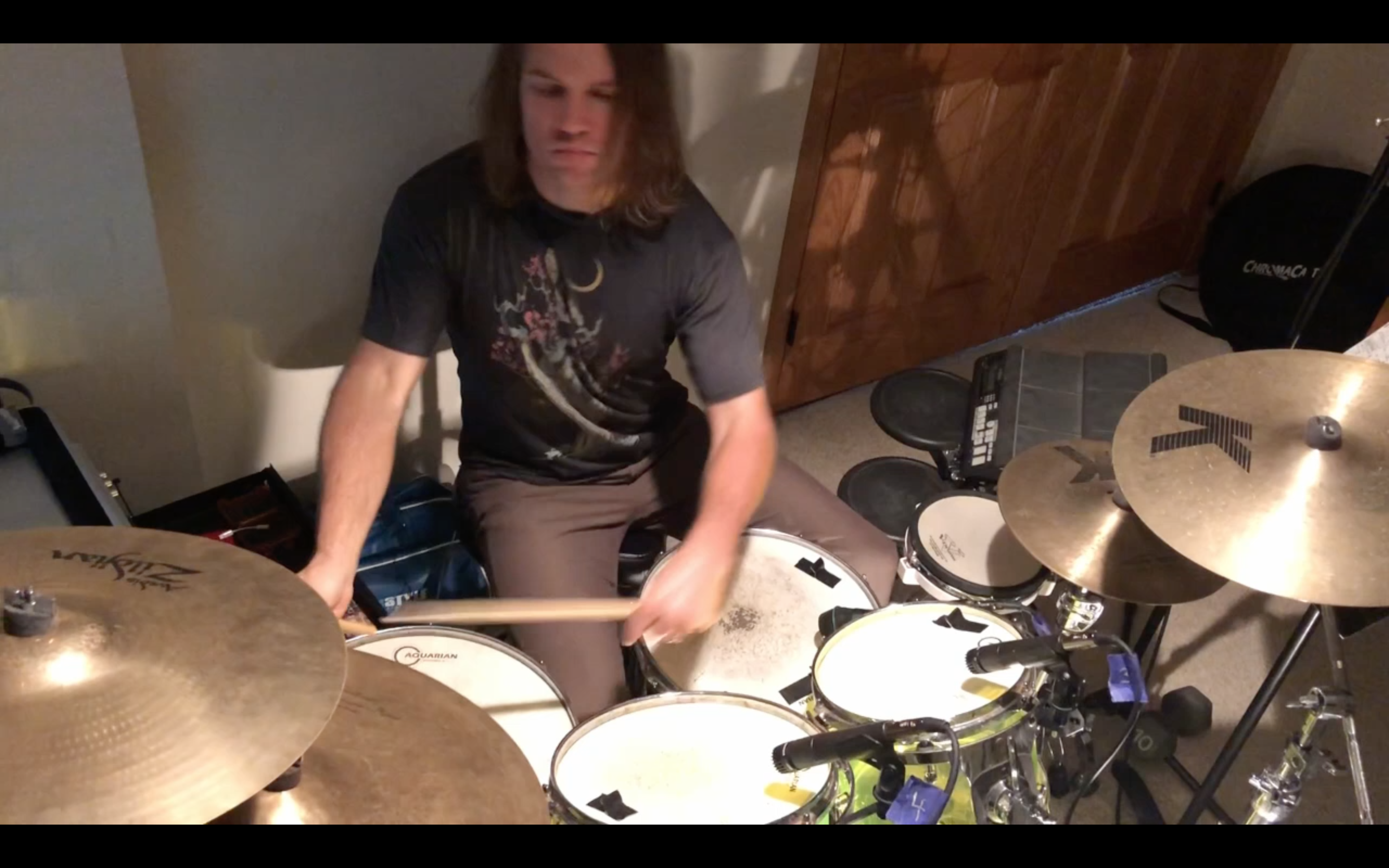
This is the “beat repeat” section of DJ Shadow's classic, "Building Steam with a Grain of Salt" (Listen on Amazon Music) from 2:44 - 4:29. What's so interesting about this album is that it was entirely created by piecing samples together straight from vinyl records. I couldn't imagine doing that now given the tools we have today! If you haven't checked it out, it is an absolute landmark for instrumental DJs, hip hop, and really just music in general. It definitely had a large impact in a lot of genres we listen to today like downtempo, chillwave, trip-hop, etc. The album is entitled "Endtroducing" by DJ Shadow (Listen on Amazon Music). (commissioned links)
I wanted to transcribe this song because it wasn't played by an actual live drummer. Therefore, it calls for an unnatural but interesting playing style. It's a unique source of inspiration for a live drummer and I'm hoping it will draw me into this style and rear its head in my playing somehow.
The use of "beat repeat" is what I think had a big part in the creation of the drum n bass genre. Drum n bass beat patterns are found all over in this clip. If you were to take a few beats from one of these measures and repeat it over and over, it would sound a lot like a drum n bass track.
I have a deep interest in live drum n bass drumming or live jungle drumming. Some drum n bass artists I like are Photek (Listen on Amazon Music) and Amon Tobin (Listen on Amazon Music). Jojo Mayer and Johnny Rabb are a couple of masters at the live drum n bass style. They definitely brought a new level of technicality to drumming. (commissioned links)
Thanks for listening.
**Full Disclosure: I earn a commission if you click any of these links and make a purchase, at no additional cost to you.**
**Copyright Statement** This video is not intended to infringe any copyright laws in any way. This is for the sole purpose of entertainment; no profit is gained from this. It is the copyrighted property of its respective owner(s).